3D Quiz
Quiz Summary
0 of 57 Questions completed
Questions:
Information
You have already completed the quiz before. Hence you can not start it again.
Quiz is loading…
You must sign in or sign up to start the quiz.
You must first complete the following:
Results
Results
0 of 57 Questions answered correctly
Your time:
Time has elapsed
You have reached 0 of 0 point(s), (0)
Earned Point(s): 0 of 0, (0)
0 Essay(s) Pending (Possible Point(s): 0)
Categories
- Not categorized 0%
- 1
- 2
- 3
- 4
- 5
- 6
- 7
- 8
- 9
- 10
- 11
- 12
- 13
- 14
- 15
- 16
- 17
- 18
- 19
- 20
- 21
- 22
- 23
- 24
- 25
- 26
- 27
- 28
- 29
- 30
- 31
- 32
- 33
- 34
- 35
- 36
- 37
- 38
- 39
- 40
- 41
- 42
- 43
- 44
- 45
- 46
- 47
- 48
- 49
- 50
- 51
- 52
- 53
- 54
- 55
- 56
- 57
- Current
- Review
- Answered
- Correct
- Incorrect
-
Question 1 of 57
1. Question
1 point(s)\(
\text { The area of one square face of a cube is equal to } 64 \mathrm{~cm}^2 \text {. Find the volume of the cube. }
\)CorrectIncorrectHint
The area of one square face is given by
\(
\mathrm{s} \times \mathrm{~s}=64 \mathrm{~cm}^2
\)
\(
\mathrm{s}=\sqrt{64}\left(\mathrm{~cm}^2\right)=8 \mathrm{~cm}
\)
The volume \(V\) of the given cube is given by
\(
V=s^3=8^3=512 \mathrm{~cm}^3
\) -
Question 2 of 57
2. Question
1 point(s)Find the volume of the given L-shaped rectangular structure.
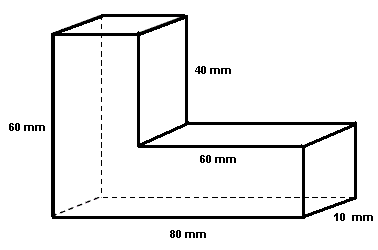 CorrectIncorrect
CorrectIncorrectHint
We can think of the given shape as a larger rectangular prism of dimensions 60,80 and \(10 \mathrm{~mm}\) from whi a smaller prism of dimensions 40,60 and \(10 \mathrm{~mm}\) has been cut. Hence the volume \(V\) of the given 3D shaape
\(
V=60 \times 80 \times 10 \mathrm{~mm}^3-40 \times 60 \times 10 \mathrm{~mm}^3=24000 \mathrm{~mm}^3
\) -
Question 3 of 57
3. Question
1 point(s)Find the volume of a cube whose side is a = 10 cm.
CorrectIncorrectHint
\(
\begin{aligned}
& \text { Volume of the cube }=a^3 \\
&=(10)^3 \\
&=1000 \mathrm{~cm}^3
\end{aligned}
\) -
Question 4 of 57
4. Question
1 point(s)Find the volume of the water tank which is in the shape of a cylinder with a radius of 10m and height of 40m.
CorrectIncorrectHint
Volume of the Cylinder,
\(
\begin{aligned}
& =\pi r^2 h \\
& =\pi(10)^2(40) \\
& =\pi 4000 \\
& =4000 \pi \\
& =4000(3.1428) \\
& =1242.8 \mathrm{~m}^3
\end{aligned}
\) -
Question 5 of 57
5. Question
1 point(s)Find the volume of an ice cream cone whose radius is 3cm and height is 4cm.
CorrectIncorrectHint
\(
\begin{aligned}
& =\frac{1}{3} \pi r^2 h \\
= & \frac{1}{3} \pi(3)^2(4) \\
= & \frac{1}{3} \pi 9 \times 4 \\
= & 12 \pi \\
= & 12(3.14) \\
= & 37.68 \mathrm{~cm}^3
\end{aligned}
\) -
Question 6 of 57
6. Question
1 point(s)Rasheed got a playing top (lattu) as his birthday present, which surprisingly had no colour on it. He wanted to colour it with his crayons. The top is shaped like a cone surmounted by a hemisphere shown in the figure below. The entire top is \(5 \mathrm{~cm}\) in height and the diameter of the top is \(3.5 \mathrm{~cm}\). Find the area he has to colour. (Take \(\pi=\frac{22}{7}\) )
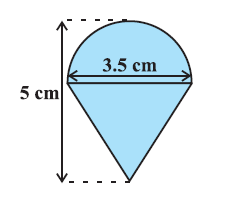 CorrectIncorrect
CorrectIncorrectHint
This top is exactly like the object we have discussed in the figure. So, we can conveniently use the result we have arrived at there. That is :
TSA of the toy \(=\) CSA of hemisphere \(+\) CSA of cone
Now, the curved surface area of the hemisphere \(=\frac{1}{2}\left(4 \pi r^2\right)=2 \pi r^2\)
\(
=\left(2 \times \frac{22}{7} \times \frac{3.5}{2} \times \frac{3.5}{2}\right) \mathrm{cm}^2
\)
Also, the height of the cone \(=\) height of the top – height (radius) of the hemispherical part
\(
=\left(5-\frac{3.5}{2}\right) \mathrm{cm}=3.25 \mathrm{~cm}
\)
So, the slant height of the cone \((l)=\sqrt{r^2+h^2}=\sqrt{\left(\frac{3.5}{2}\right)^2+(3.25)^2} \mathrm{~cm}=3.7 \mathrm{~cm}\) (approx.)
Therefore, \(\mathrm{CSA}\) of cone \(=\pi r l=\left(\frac{22}{7} \times \frac{3.5}{2} \times 3.7\right) \mathrm{cm}^2\)
This gives the surface area of the top as
\(
\begin{aligned}
& =\left(2 \times \frac{22}{7} \times \frac{3.5}{2} \times \frac{3.5}{2}\right) \mathrm{cm}^2+\left(\frac{22}{7} \times \frac{3.5}{2} \times 3.7\right) \mathrm{cm}^2 \\
& =\frac{22}{7} \times \frac{3.5}{2}(3.5+3.7) \mathrm{cm}^2=\frac{11}{2} \times(3.5+3.7) \mathrm{cm}^2=39.6 \mathrm{~cm}^2 \text { (approx.) }
\end{aligned}
\) -
Question 7 of 57
7. Question
1 point(s)The decorative block shown in Figure below is made of two solids – a cube and a hemisphere. The base of the block is a cube with edge \(5 \mathrm{~cm}\), and the hemisphere fixed on the top has a diameter of \(4.2 \mathrm{~cm}\). Find the total surface area of the block. \(\left(\right.\) Take \(\pi=\frac{22}{7}\) )
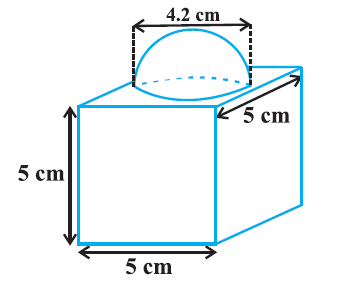 CorrectIncorrect
CorrectIncorrectHint
The total surface area of the cube \(=6 \times(\text { edge })^2=6 \times 5 \times 5 \mathrm{~cm}^2=150 \mathrm{~cm}^2\).
Note that the part of the cube where the hemisphere is attached is not included in the surface area.
So, the surface area of the block \(=\) TSA of cube – base area of hemisphere \(+\) CSA of hemisphere
\(
=150-\pi r^2+2 \pi r^2=\left(150+\pi r^2\right) \mathrm{cm}^2
\)
\(=150 \mathrm{~cm}^2+\left(\frac{22}{7} \times \frac{4.2}{2} \times \frac{4.2}{2}\right) \mathrm{cm}^2\)
\(=(150+13.86) \mathrm{cm}^2=163.86 \mathrm{~cm}^2\) -
Question 8 of 57
8. Question
1 point(s)A wooden toy rocket is in the shape of a cone mounted on a cylinder, as shown in the figure below. The height of the entire rocket is \(26 \mathrm{~cm}\), while the height of the conical part is \(6 \mathrm{~cm}\). The base of the conical portion has a diameter of \(5 \mathrm{~cm}\), while the base diameter of the cylindrical portion is \(3 \mathrm{~cm}\). If the conical portion is to be painted orange and the cylindrical portion yellow, find the area of the rocket painted with each of these colours. (Take \(\pi=3.14\) )
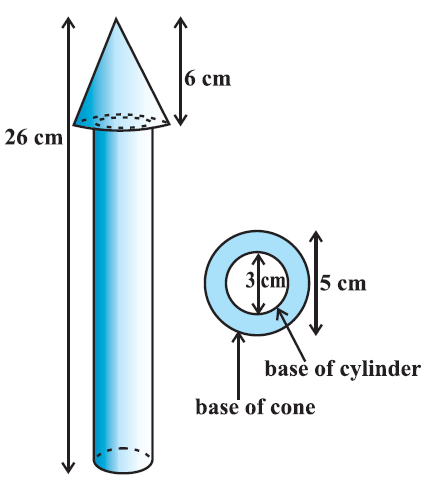 CorrectIncorrect
CorrectIncorrectHint
Denote radius of clone by \(r\), slant height of cone by \(l\), height of cone by \(h\), radius of cylinder by \(r^{\prime}\) and height of cylinder by \(h^{\prime}\). Then \(r=2.5 \mathrm{~cm}, h=6 \mathrm{~cm}, r^{\prime}=1.5 \mathrm{~cm}\), \(h^{\prime}=26-6=20 \mathrm{~cm}\) and
\(
l=\sqrt{r^2+h^2}=\sqrt{2.5^2+6^2} \mathrm{~cm}=6.5 \mathrm{~cm}
\)
Here, the conical portion has its circular base resting on the base of the cylinder, but the base of the cone is larger than the base of the cylinder. So, a part of the base of the cone (a ring) is to be painted.So, the area to be painted orange \(=\mathrm{CSA}\) of the cone \(+\) base area of the cone – base area of the cylinder
\(
\begin{aligned}
& =\pi r l+\pi r^2-\pi\left(r^{\prime}\right)^2 \\
& =\pi\left[(2.5 \times 6.5)+(2.5)^2-(1.5)^2\right] \mathrm{cm}^2 \\
& =\pi[20.25] \mathrm{cm}^2=3.14 \times 20.25 \mathrm{~cm}^2 \\
& =63.585 \mathrm{~cm}^2
\end{aligned}
\)
Now, the area to be painted yellow \(=\) CSA of the cylinder
\(+\) area of one base of the cylinder
\(
\begin{aligned}
& =2 \pi r^{\prime} h^{\prime}+\pi\left(r^{\prime}\right)^2 \\
& =\pi r^{\prime}\left(2 h^{\prime}+r^{\prime}\right) \\
& =(3.14 \times 1.5)(2 \times 20+1.5) \mathrm{cm}^2 \\
& =4.71 \times 41.5 \mathrm{~cm}^2 \\
& =195.465 \mathrm{~cm}^2
\end{aligned}
\) -
Question 9 of 57
9. Question
1 point(s)Mayank made a bird-bath for his garden in the shape of a cylinder with a hemispherical depression at one end (see Figure below). The height of the cylinder is \(1.45 \mathrm{~m}\) and its radius is \(30 \mathrm{~cm}\). Find the total surface area of the bird-bath. (Take \(\pi=\frac{22}{7}\) )
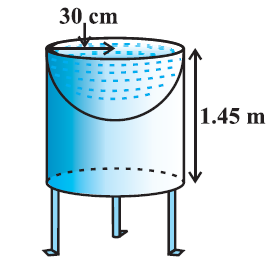 CorrectIncorrect
CorrectIncorrectHint
Let \(h\) be the height of the cylinder, and \(r\) the common radius of the cylinder and hemisphere. Then,
the total surface area of the bird-bath \(=\) CSA of cylinder \(+\) CSA of hemisphere
\(
\begin{aligned}
& =2 \pi r h+2 \pi r^2=2 \pi r(h+r) \\
& =2 \times \frac{22}{7} \times 30(145+30) \mathrm{cm}^2 \\
& =33000 \mathrm{~cm}^2=3.3 \mathrm{~m}^2
\end{aligned}
\) -
Question 10 of 57
10. Question
1 point(s)2 cubes each of volume \(64 \mathrm{~cm}^3\) are joined end to end. Find the surface area of the resulting cuboid.
CorrectIncorrectHint
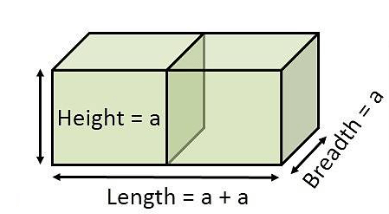
\(
\begin{aligned}
& \text { length of cube }=\mathrm{a} \\
& \mathrm{a}^3=64 \\
& \Rightarrow \mathrm{a}=4 \\
& \text { Length of cuboid }=8=l \\
& \text { breadth of cuboid }=4=\mathrm{b} \\
& \text { height of cuboid = } 4=\mathrm{h} \\
& \text { Ref. image } \\
& \text { Surface area } \Rightarrow 2(\mathrm{lb}+\mathrm{bh}+\mathrm{lh}) \\
& =2((8 \times 4)+(4 \times 4)+(8 \times 4)) \\
& =2(32+16+32) \\
& =160 \mathrm{~cm}^2
\end{aligned}
\) -
Question 11 of 57
11. Question
1 point(s)A vessel is in the form of a hollow hemisphere mounted by a hollow cylinder. The diameter of the hemisphere is 14 cm and the total height of the vessel is 13 cm. Find the inner surface area of the vessel.
CorrectIncorrectHint
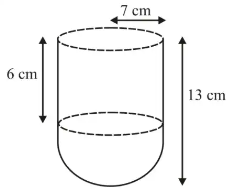
The radius(r) of the cylindrical part and the hemispherical part is the same (i.e., \(7 \mathrm{~cm}\) )
Height of hemispherical part \(=\) Radius \(=7 \mathrm{~cm}\)
Height of cylindrical part \((\mathrm{h})=13-7=6 \mathrm{~cm}\)
Inner surface are of the vessel \(=\) CSA of cylindrical part \(+\) CSA of hemispherical part
\(
=2 \pi \mathrm{rh}+2 \pi \mathrm{r}^2
\)
\(
\begin{aligned}
& \text { Inner surface area of vessel }=2 \times \frac{22}{7} \times 7 \times 6+2 \times \frac{22}{7} \times 7 \times 7 \\
& =44(6+7) \\
& =44 \times 13 \\
& =572 \mathrm{~cm}^2
\end{aligned}
\) -
Question 12 of 57
12. Question
1 point(s)A toy is in the form of a cone of radius 3.5 cm mounted on a hemisphere of same radius. The total height of the toy is 15.5 cm. Find the total surface area of the toy.
CorrectIncorrectHint
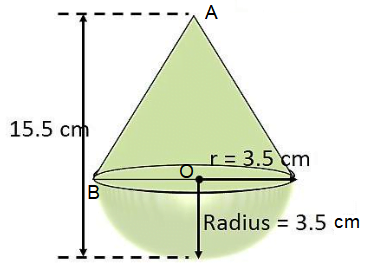
Radius of Cone \(=r=3.5 \mathrm{~cm}\)
Total Height of toy \(=15.5 \mathrm{~cm}\)
Radius of Hemisphere \(=\) radius of cone \(=r=3.5 \mathrm{~cm}\)
Height of cone \(=\mathrm{h}\)
\(
\begin{aligned}
& \Rightarrow \mathrm{AO}=\mathrm{h} \\
& \mathrm{h}=\text { Total height of toy }-\text { radius of hemisphere }=15.5-3.5=12 \mathrm{~cm}
\end{aligned}
\)
In \(\triangle \mathrm{AOB}, \mathrm{AO}=\mathrm{h}=\) Height of cone,
we can apply Pythagoras Theorem to find slant height of the cone.
Slant height of cone
\(
\begin{aligned}
& =A B=1=\sqrt{r^2+h^2} \\
& =\sqrt{(3.5)^2+(12)^2}=\sqrt{12.25+144} \\
& =\sqrt{156.25}=12.5 \mathrm{~cm}
\end{aligned}
\)
Total surface area of toy
\(=\) Surface area of Cone \(+\) Surface area of Hemisphere
\(
=\pi \cdot r \cdot l+2 \cdot \pi \cdot r^2
\)
\(
=\left(\frac{22}{7} \times 3.5 \times 12.5\right)+2 \times \frac{22}{7} \times 3.5 \times 3.5
\)
\(
=137.5+77=214.5 \mathrm{~cm}^2
\) -
Question 13 of 57
13. Question
1 point(s)A cubical block of side 7 cm is surmounted by a hemisphere. What is the greatest diameter the hemisphere can have? Find the surface area of the solid.
CorrectIncorrectHint
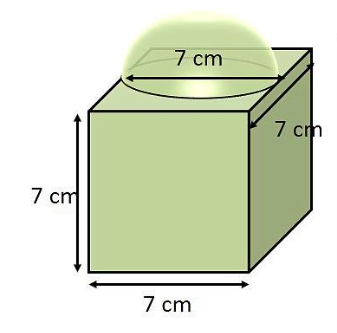
The diagram shows that the greatest diameter possible for such hemisphere is equal to the length of cube edge, i.e., \(7 \mathrm{~cm}\).
Radius (r) of hemispherical part \(=\frac{7}{2}=3.5 \mathrm{~cm}\)
Total surface area of solid = Surface area of remaining cubical part \(+\) CSA of hemispherical part + Area of base of hemispherical part
\(
\begin{aligned}
& =6 a^2+2 \pi r^2-\pi r^2 \\
=6 a^2+\pi r^2 & \\
& =6(7)^2+\frac{22}{7} \times \frac{7}{2} \times \frac{7}{2} \\
& =294+38.5 \\
& =332.5 \mathrm{~cm}^2
\end{aligned}
\) -
Question 14 of 57
14. Question
1 point(s)A hemispherical depression is cut out from one face of a cubical wooden block such that the diameter \(l\) of the hemisphere is equal to the edge of the cube. Determine the surface area of the remaining solid.
CorrectIncorrectHint
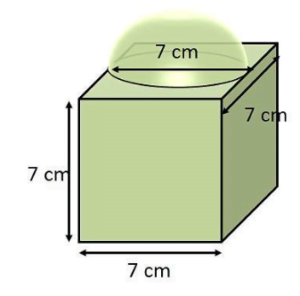
Let, Length of each edge of cubical block \(=\) Diameter of hemisphere \(=l\)
\(\therefore\) Radius of hemisphere,
Total surface area of newly formed cube = Curved surface area of cube – Upper part of Cube \(+\) Area of hemisphere which is depressed
\(
\begin{aligned}
& =6 l^2-\pi\left(\frac{l}{2}\right)^2+2 \pi\left(\frac{l}{2}\right)^2 \\
& =6 l^2+\pi\left(\frac{l}{2}\right)^2 \\
& =\frac{1}{4}\left(24 l^2+\pi l^2\right) \\
& =\frac{1}{4} l^2(24+\pi)
\end{aligned}
\) -
Question 15 of 57
15. Question
1 point(s)A medicine capsule is in the shape of a cylinder with two hemispheres stuck to each of its ends (see Fig. below). The length of the entire capsule is 14 mm and the diameter of the capsule is 5 mm. Find its surface area.
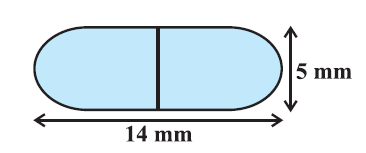 CorrectIncorrect
CorrectIncorrectHint

Length of Capsule \( l=14 \mathrm{~mm}\)
Diameter of Capsule \(=\) Diameter of Cylinder \(=5 \mathrm{~mm}\)
Radius \(=\frac{\text { Diameter }}{2}\)
Therefore, Radius of each Hemisphere \(=\) Radius of Cylinder \(=\mathrm{r}=\frac{5}{2}=2.5 \mathrm{~mm}\)
Length of Cylinder \(=\mathrm{AB}=\) Total length of Capsule \(–\) Radius of left Hemisphere – Radius of Right Hemisphere
\(
=14-2.5-2.5=9 \mathrm{~mm}
\)
Surface Area of Capsule \(=\) Curved Surface Area of Cylinder \(+\) Surface Area of
Left Hemisphere \(+\) Surface Area of Right Hemisphere
\(
\begin{aligned}
& =2 \pi r {l}+2 \pi \mathrm{r}^2+2 \pi \mathrm{r}^2 \\
& =2 \pi {rl}+4 \pi \mathrm{r}^2 \\
& =2 \times \frac{22}{7} \times 2.5 \times 9+4 \times \frac{22}{7} \times 2.5^2 \\
& =\frac{22}{7}[45+25]=\frac{22}{7} \times 70=220 \mathrm{~mm}^2
\end{aligned}
\) -
Question 16 of 57
16. Question
1 point(s)A tent is in the shape of a cylinder surmounted by a conical top. If the height and diameter of the cylindrical part are \(2.1 \mathrm{~m}\) and \(4 \mathrm{~m}\) respectively, and the slant height of the top is \(2.8 \mathrm{~m}\), find the area of the canvas used for making the tent. Also, find the cost of the canvas of the tent at the rate of Rs 500 per \(^2\). (Note that the base of the tent will not be covered with canvas.)
CorrectIncorrectHint
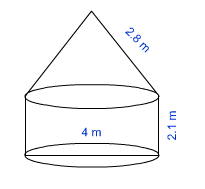
Height (h) of the cylindrical part \(=2.1 \mathrm{~m}\)
Diameter of the cylindrical part \(=4 \mathrm{~m}\)
Radius of the cylindrical part \(=2 \mathrm{~m}\)
Slant height (l) of conical part \(=2.8 \mathrm{~m}\)
Area of canvas used \(=\) CSA of conical part \(+\) CSA of cylindrical part
\(=\pi \mathrm{rl}+2 \pi \mathrm{rh}\)
\(=\pi \times 2 \times 2.8+2 \pi \times 2 \times 2.1\)
\(=2 \pi[2.8+4.2]\)
\(=2 \times \frac{22}{7} \times 7\)
\(=44 \mathrm{~m}^2\)
Cost of \(1 \mathrm{~m}^2\) canvas \(=500\) rupees
Cost of \(44 \mathrm{~m}^2\) canvas \(=44 \times 500=22000\) rupees.
Therefore, it will cost 22000 rupees for making such a tent. -
Question 17 of 57
17. Question
1 point(s)From a solid cylinder whose height is \(2.4 \mathrm{~cm}\) and diameter \(1.4 \mathrm{~cm}\), a conical cavity of the same height and same diameter is hollowed out. Find the total surface area of the remaining solid to the nearest \(\mathrm{cm}^2\).
CorrectIncorrectHint
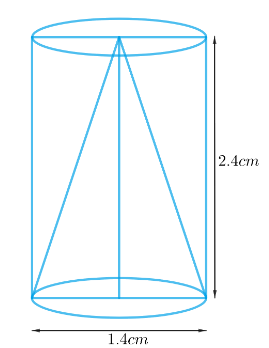
Height of the cylinder \(=\) Height of the cone \(=\mathrm{h}=2.4 \mathrm{~cm}\)
Diameter of the cylinder \(=\) diameter of the cone \(=d=1.4 \mathrm{~cm}\)
Radius of the cylinder \(=\) radius of the cone \(=r=d / 2=1.4 / 2 \mathrm{~cm}=0.7 \mathrm{~cm}\)
Slant height of the cone, \(l=\sqrt{\left[r^2+h^2\right]}\)
\(
\begin{aligned}
& l=\sqrt{\left[(0.7 \mathrm{~cm})^2+(2.4 \mathrm{~cm})^2\right]} \\
& =\sqrt{\left[0.49 \mathrm{~cm}^2+5.76 \mathrm{~cm}^2\right]} \\
& =\sqrt{\left[6.25 \mathrm{~cm}^2\right]} \\
& =2.5 \mathrm{~cm}
\end{aligned}
\)
TSA of the remaining solid = CSA of the cylindrical part + CSA of conical part + Area of one cylindrical base
\(
\begin{aligned}
& =2 \pi r h+\pi r l+\pi r^2 \\
& =\pi r(2 h+l+r) \\
& =22 / 7 \times 0.7 \mathrm{~cm} \times(2 \times 2.4 \mathrm{~cm}+2.5 \mathrm{~cm}+0.7 \mathrm{~cm}) \\
& =2.2 \mathrm{~cm} \times 8 \mathrm{~cm} \\
& =17.6 \mathrm{~cm}^2
\end{aligned}
\)
Hence, the total surface area of the remaining solid to the nearest \(\mathrm{cm}^2\) is \(18 \mathrm{~cm}^2\). -
Question 18 of 57
18. Question
1 point(s)A wooden article was made by scooping out a hemisphere from each end of a solid cylinder, as shown in the figure below. If the height of the cylinder is 10 cm, and its base is of radius 3.5 cm, find the total surface area of the article.
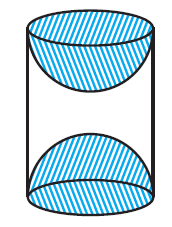 CorrectIncorrect
CorrectIncorrectHint
Given that a wooden article is made by scooping out a hemisphere each from the top and bottom of a solid cylinder with \(\mathrm{h}=10 \mathrm{~cm}\) and \(\mathrm{r}=3.5 \mathrm{~cm}\)
To find out: The total surface area of the article.
Total surface area of the article \(=\) Lateral surface area of cylinder \(+2 \times\) Curved surface area of hemisphere
We know that the lateral surface are of a cylinder \(=2 \pi \mathrm{rh}\).
And the curved surface area of a hemisphere \(=2 \pi r^2\).
\(
\begin{aligned}
& \therefore \text { TSA of article }=2 \pi \mathrm{rh}+2 \times 2 \mathrm{r}^2 \\
& \Rightarrow 2 \times \frac{22}{7} \times \frac{7}{2} \times 10+2 \times 2 \times \frac{22}{7} \times\left(\frac{7}{2}\right)^2 \\
& \Rightarrow 22 \times 10+22 \times 7 \\
& \Rightarrow 22(10+7) \\
& \Rightarrow 22 \times 17 \\
& \therefore \text { TSA }=374 \mathrm{~cm}^2
\end{aligned}
\)
Hence, the total surface area of the article is \(374 \mathrm{~cm}^2\). -
Question 19 of 57
19. Question
1 point(s)Shanta runs an industry in a shed which is in the shape of a cuboid surmounted by a half cylinder (see figure below). If the base of the shed is of dimension \(7 \mathrm{~m} \times 15 \mathrm{~m}\), and the height of the cuboidal portion is \(8 \mathrm{~m}\), find the volume of air that the shed can hold. Further, suppose the machinery in the shed occupies a total space of \(300 \mathrm{~m}^3\), and there are 20 workers, each of whom occupy about \(0.08 \mathrm{~m}^3\) space on an average. Then, how much air is in the shed? (Take \(\pi=\frac{22}{7}\) )
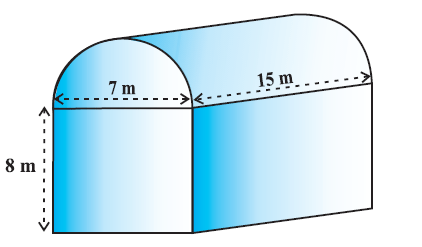 CorrectIncorrect
CorrectIncorrectHint
The volume of air inside the shed (when there are no people or machinery) is given by the volume of air inside the cuboid and inside the half cylinder, taken together.
Now, the length, breadth and height of the cuboid are \(15 \mathrm{~m}, 7 \mathrm{~m}\) and \(8 \mathrm{~m}\), respectively.
Also, the diameter of the half cylinder is \(7 \mathrm{~m}\) and its height is \(15 \mathrm{~m}\).
So, the required volume \(=\) volume of the cuboid \(+\frac{1}{2}\) volume of the cylinder
\(
=\left[15 \times 7 \times 8+\frac{1}{2} \times \frac{22}{7} \times \frac{7}{2} \times \frac{7}{2} \times 15\right] \mathrm{m}^3=1128.75 \mathrm{~m}^3
\)
Next, the total space occupied by the machinery \(=300 \mathrm{~m}^3\)
And the total space occupied by the workers \(=20 \times 0.08 \mathrm{~m}^3=1.6 \mathrm{~m}^3\)
Therefore, the volume of the air, when there are machinery and workers
\(
=1128.75-(300.00+1.60)=827.15 \mathrm{~m}^3
\) -
Question 20 of 57
20. Question
1 point(s)A juice seller was serving his customers using glasses as shown in Fig. 13.13. The inner diameter of the cylindrical glass was \(5 \mathrm{~cm}\), but the bottom of the glass had a hemispherical raised portion which reduced the capacity of the glass. If the height of a glass was \(10 \mathrm{~cm}\), find the apparent capacity of the glass and its actual capacity. (Use \(\pi=3.14\).)
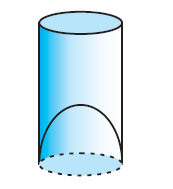 CorrectIncorrect
CorrectIncorrectHint
Since the inner diameter of the glass \(=5 \mathrm{~cm}\) and height \(=10 \mathrm{~cm}\), the apparent capacity of the glass \(=\pi r^2 h\)
\(
=3.14 \times 2.5 \times 2.5 \times 10 \mathrm{~cm}^3=196.25 \mathrm{~cm}^3
\)
But the actual capacity of the glass is less by the volume of the hemisphere at the base of the glass.
i.e.,
\(
\text { it is less by } \frac{2}{3} \pi r^3=\frac{2}{3} \times 3.14 \times 2.5 \times 2.5 \times 2.5 \mathrm{~cm}^3=32.71 \mathrm{~cm}^3
\)
So, the actual capacity of the glass = apparent capacity of glass – volume of the hemisphere
\(
\begin{aligned}
& =(196.25-32.71) \mathrm{cm}^3 \\
& =163.54 \mathrm{~cm}^3
\end{aligned}
\) -
Question 21 of 57
21. Question
1 point(s)A solid toy is in the form of a hemisphere surmounted by a right circular cone. The height of the cone is \(2 \mathrm{~cm}\) and the diameter of the base is \(4 \mathrm{~cm}\). Determine the volume of the toy. If a right circular cylinder circumscribes the toy, find the difference of the volumes of the cylinder and the toy. (Take \(\pi=3.14)\)
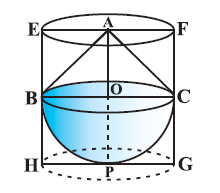 CorrectIncorrect
CorrectIncorrectHint
Let BPC be the hemisphere and \(\mathrm{ABC}\) be the cone standing on the base of the hemisphere (see Figure below). The radius BO of the hemisphere (as well as of the cone \()=\frac{1}{2} \times 4 \mathrm{~cm}=2 \mathrm{~cm}\).
So, volume of the toy \(=\frac{2}{3} \pi r^3+\frac{1}{3} \pi r^2 h\)
\(
=\left[\frac{2}{3} \times 3.14 \times(2)^3+\frac{1}{3} \times 3.14 \times(2)^2 \times 2\right] \mathrm{cm}^3=25.12 \mathrm{~cm}^3
\)
Now, let the right circular cylinder EFGH circumscribe the given solid. The radius of the base of the right circular cylinder \(=\mathrm{HP}=\mathrm{BO}=2 \mathrm{~cm}\), and its height is
\(
\mathrm{EH}=\mathrm{AO}+\mathrm{OP}=(2+2) \mathrm{cm}=4 \mathrm{~cm}
\)
So, the volume required \(=\) volume of the right circular cylinder \(–\) volume of the toy
\(
\begin{aligned}
& =\left(3.14 \times 2^2 \times 4-25.12\right) \mathrm{cm}^3 \\
& =25.12 \mathrm{~cm}^3
\end{aligned}
\)
Hence, the required difference of the two volumes \(=25.12 \mathrm{~cm}^3\). -
Question 22 of 57
22. Question
1 point(s)A solid is in the shape of a cone standing on a hemisphere with both their radii being equal to \(1 \mathrm{~cm}\) and the height of the cone is equal to its radius. Find the volume of the solid in terms of \(\pi\).
CorrectIncorrectHint
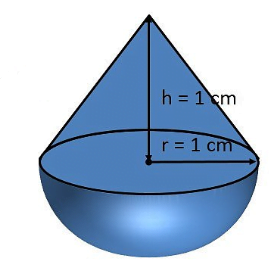
\(
\begin{aligned}
& r=1 \mathrm{~cm} \\
& h=1 \mathrm{~cm}
\end{aligned}
\)
We have to find out the volume of the solid in terms of \(\pi\) Total Volume \(=\) Volume of cone \(+\) Volume of Hemisphere We know that:
Volume of cone \(=\frac{1}{3} \pi r^2 h\)
Volume of hemisphere \(=\frac{2}{3} \pi r^3\)
\(
\begin{aligned}
= & \frac{1}{3} \pi \mathrm{r}^2 \mathrm{~h}+\frac{2}{3} \pi \mathrm{r}^3 \\
= & \frac{1}{3} \pi \mathrm{r}^2(\mathrm{~h}+2 \mathrm{r}) \\
= & \frac{1}{3} \times \pi \times 1 \times 1 \times(1+2) \\
= & \pi \mathrm{cm}^3
\end{aligned}
\)
Hence, the volume of the solid is \(\pi \mathrm{cm}^3\). -
Question 23 of 57
23. Question
1 point(s)Rachel, an engineering student, was asked to make a model shaped like a cylinder with two cones attached at its two ends by using a thin aluminium sheet. The diameter of the model is \(3 \mathrm{~cm}\) and its length is \(12 \mathrm{~cm}\). If each cone has a height of \(2 \mathrm{~cm}\), find the volume of air contained in the model that Rachel made. (Assume the outer and inner dimensions of the model to be nearly the same.)
CorrectIncorrectHint
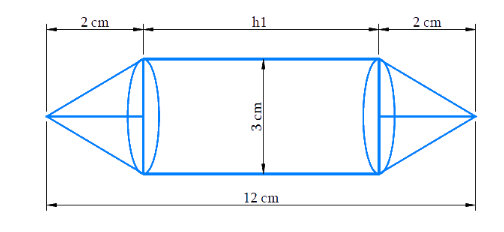
The volume of the model \(=\) Volume of the 2 conical parts \(+\) Volume of the cylindrical part. As the length of the model includes the height of the cylindrical part and the height of both the identical conical parts. Length of the model \(=\) Height of the cylindrical part \(+2 \times\) Height of the conical part. We will find the volume of the model by using formulae; Volume of the cylinder \(=\pi r^2 h_1\), where \(r\) and \(h_1\) are the radius and height of the cylinder respectively. Volume of the cone \(=1 / 3 \pi r^2 h_2\), where \(r\) and \(h_2\) are the radius and height of the cone respectively. Height of each conical part, \(h_2=2 \mathrm{~cm}\)
Height of cylindrical part \(=\) Length of the model \(-2 \times\) Height of the conical part
\(\mathrm{h}_1=12 \mathrm{~cm}-2 \times 2 \mathrm{~cm}=8 \mathrm{~cm}\)
Diameter of the model, \(d=3 \mathrm{~cm}\)
Radius of cylindrical part \(=\) radius of conical part \(=r=3 / 2 \mathrm{~cm}=1.5 \mathrm{~cm}\)
Volume of the model \(=2 \times\) Volume of the conical part \(+\) Volume of the cylindrical part
\(
\begin{aligned}
& =2 \times 1 / 3 \pi r^2 h_2+\pi r^2 h_1 \\
& =\pi r^2\left(2 / 3 h_2+h_1\right) \\
& =22 / 7 \times 1.5 \mathrm{~cm} \times 1.5 \mathrm{~cm} \times(2 / 3 \times 2 \mathrm{~cm}+8 \mathrm{~cm}) \\
& =22 / 7 \times 1.5 \mathrm{~cm} \times 1.5 \mathrm{~cm} \times 28 / 3 \mathrm{~cm} \\
& =66 \mathrm{~cm}^3
\end{aligned}
\)
Thus, the volume of air in the model is \(66 \mathrm{~cm}^3\). -
Question 24 of 57
24. Question
1 point(s)A gulab jamun contains sugar syrup up to about \(30 \%\) of its volume. Find approximately how much syrup would be found in 45 gulab jamums, each shaped like a cylinder with two hemispherical ends with length \(5 \mathrm{~cm}\) and diameter \(2.8 \mathrm{~cm}\) (see Figure below).
CorrectIncorrectHint
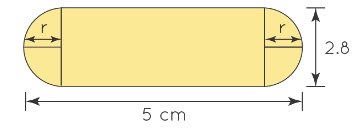
Length of cylindrical part \(=\) Length of a Gulab jamun \(-2 \times\) radius of the hemispherical part. Also, the Diameter of Gulab jamun = diameter of the cylindrical part
Radius of cylindrical part \(=\) radius of hemispherical part
In order to find the volume of sugar syrup in 45 Gulab jamuns, we need to find the volume of all the gulab jamun.
As it’s given a Gulab jamun contains sugar syrup up to about \(30 \%\) of its volume. We make an assumption to every Gulab jamun contains sugar syrup at \(30 \%\) of its volume to simplify the calculation. Volume of sugar syrup \(=30 \%\) of the volume of 45 gulab jamuns.
Diameter of the Gulab jamun, \(d=2.8 \mathrm{~cm}\)
Radius of cylindrical part \(=\) radius of hemispherical part \(r=d / 2=2.8 / 2 \mathrm{cm}=1.4 \mathrm{~cm}\)
Length of cylindrical part, \(h=5 \mathrm{~cm}-2 \times 1.4 \mathrm{~cm}=2.2 \mathrm{~cm}\)
Volume of one Gulab jamun = volume of cylindrical part \(+2 \times\) volume of the hemispherical parts
\(
\begin{aligned}
& =\pi r^2 h+2 \times 2 / 3 \pi r^3 =\pi r^2 h+4 / 3 \pi r^3=\pi r^2(h+4 r / 3) \\
& =22 / 7 \times 1.4 \mathrm{~cm} \times 1.4 \mathrm{~cm} \times(2.2 \mathrm{~cm}+(4 / 3) \times 1.4 \mathrm{~cm}) \\
& =[22 / 7 \times 1.4 \mathrm{~cm} \times 1.4 \mathrm{~cm} \times(12.2 / 3 \mathrm{~cm})] \\
& =75.152 / 3 \mathrm{~cm}^3
\end{aligned}
\)
Volume of 45 Gulab jamuns \(=45 \times\) volume of one Gulab jamun
\(
\begin{aligned}
& =45 \times 75.152 / 3 \mathrm{~cm}^3 =15 \times 75.152 \mathrm{~cm}^3 =1127.28 \mathrm{~cm}^3
\end{aligned}
\)
Volume of sugar syrup in 45 Gulab jamuns \(=30 \%\) of volume of 45 Gulab jamun
\(=30 / 100 \times 1127.28 \mathrm{~cm}^3\)
Volume of sugar syrup in 45 Gulab jamuns \(=30 \%\) of volume of 45 Gulab jamun
\(\begin{aligned}
& =30 / 100 \times 1127.28 \mathrm{~cm}^3 =338.184 \mathrm{~cm}^3\approx 338 \mathrm{~cm}^3
\end{aligned}\) -
Question 25 of 57
25. Question
1 point(s)A pen stand made of wood is in the shape of a cuboid with four conical depressions to hold pens. The dimensions of the cuboid are 15 cm by 10 cm by 3.5 cm. The radius of each of the depressions is 0.5 cm and the depth is 1.4 cm. Find the volume of wood in the entire stand (see figure below).
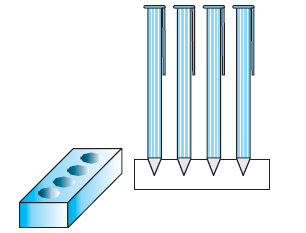 CorrectIncorrect
CorrectIncorrectHint
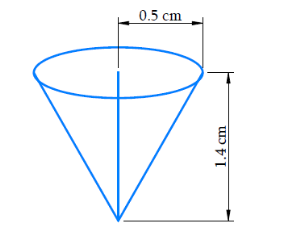
From the above figure, we can see that the conical depressions do not contain wood. Since the dimensions of all 4 conical depressions are the same, their volumes will also be identical.
The volume of wood in the entire pen stand = Volume of the wooden cuboid \(4 \times\) Volume of the conical depression
We will find the volume of the solid by using formulae;
Volume of the cuboid = Ibh, where I, b, and \(\mathrm{h}\) are the length, breadth, and height of the cuboid respectively.Volume of the cone \(=1 / 3 \pi r^2 h_1\), where \(r\) and \(h_1\) are the radius and height of the cone respectively.
Depth of each conical depression, \(h_1=1.4 \mathrm{~cm}\)
Radius of each conical depression, \(r=0.5 \mathrm{~cm}\)
Dimensions of the cuboid are \(15 \mathrm{~cm} \times 10 \mathrm{~cm} \times 3.5 \mathrm{~cm}\)
The volume of wood in the entire pen stand = volume of the wooden cuboid –
\(4 \times\) volume of the conical depression
\(
\begin{aligned}
& =l \times \mathrm{b} \times \mathrm{h}-4 \times 1 / 3 \pi \mathrm{r}^2 \mathrm{~h}_1 \\
& =(15 \mathrm{~cm} \times 10 \mathrm{~cm} \times 3.5 \mathrm{~cm})-(4 \times 1 / 3 \times 22 / 7 \times 0.5 \mathrm{~cm} \times 0.5 \mathrm{~cm} \times 1.4 \mathrm{~cm}) \\
& =525 \mathrm{~cm}^3-1.47 \mathrm{~cm}^3 \\
& =523.53 \mathrm{~cm}^3
\end{aligned}
\)
The volume of wood in the entire stand is \(523.53 \mathrm{~cm}^3\). -
Question 26 of 57
26. Question
1 point(s)A vessel is in the form of an inverted cone. Its height is 8 cm and the radius of its top, which is open, is 5 cm. It is filled with water up to the brim. When lead shots, each of which is a sphere of radius 0.5 cm are dropped into the vessel, one-fourth of the water flows out. Find the number of lead shots dropped in the vessel.
CorrectIncorrectHint
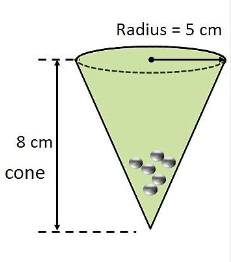
Volume of water flown out
Volume of water flown out \(=\frac{1}{4}\) of volume of cone
Given, radius of cone \(=r=5 \mathrm{~cm}\), height of cone \(=\mathrm{h}=8 \mathrm{~cm}\)
\(
\begin{aligned}
& \text { Volume of cone }=\frac{1}{3} \pi r^2 h \\
& =\frac{1}{3} \times \frac{22}{7} \times 5 \times 5 \times 8 \\
& =\frac{4400}{21} \mathrm{~cm}^3
\end{aligned}
\)
Volume of water flown out \(=\frac{1}{4} \times\) Volume of cone
\(
=\frac{1}{4} \times \frac{4400}{21}=\frac{1100}{21} \mathrm{~cm}^3
\)
Volume of 1 lead shot
Lead shot is in from of sphere with
Radius \(=r=0.5 \mathrm{~cm}\)
Volume of 1 lead shot = Volume of sphere
\(
=\frac{4}{3} \pi r^3=\frac{4}{3} \times \frac{22}{7} \times(0.5)^3=\frac{11}{21} \mathrm{~cm}^3
\)
Now,
\(
\begin{aligned}
\text { Number of lead shots } & =\frac{\text { Volume of } \text { water flown out }}{\text { Volume of } 1 \text { lead shot }} \\
& =\frac{\frac{1100}{21}}{\frac{11}{21}} \\
& =\frac{1100}{21} \times \frac{21}{11} \\
& =100
\end{aligned}
\) -
Question 27 of 57
27. Question
1 point(s)A solid iron pole consists of a cylinder of height \(220 \mathrm{~cm}\) and base diameter \(24 \mathrm{~cm}\), which is surmounted by another cylinder of height \(60 \mathrm{~cm}\) and radius \(8 \mathrm{~cm}\). Find the mass of the pole, given that \(1 \mathrm{~cm}^3\) of iron has approximately \(8 \mathrm{~g}\) mass. (Use \(\pi=3.14\) )
CorrectIncorrectHint
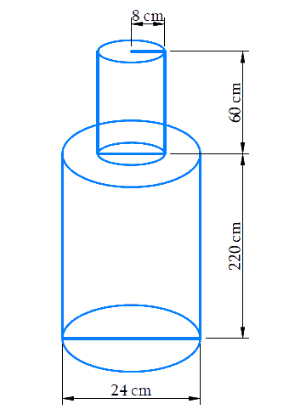
We can see that, the Volume of the solid iron pole \(=\) volume of larger cylinder \(+\) volume of the smaller cylinder
Mass of iron in the pole \(=8 \mathrm{~g} \times\) volume of the solid iron pole in \(\mathrm{cm}^3\)
Volume of the cylinder \(=\pi r^2 \mathrm{~h}\) where \(r\) and \(\mathrm{h}\) are the radius and height of the cylinder respectively
Radius of larger cylinder, \(R=24 \mathrm{~cm} / 2=12 \mathrm{~cm}\)
Height of larger cylinder, \(\mathrm{H}=220 \mathrm{~cm}\)
Radius of smaller cylinder, \(r=8 \mathrm{~cm}\)
Height of smaller cylinder, \(h=60 \mathrm{~cm}\)
Volume of the solid iron pole \(=\) volume of larger cylinder \(+\) volume of smaller cylinder
\(
\begin{aligned}
& =\pi R^2 \mathrm{H}+\pi \mathrm{r}^2 \mathrm{~h} \\
& =\pi(12 \mathrm{~cm} \times 12 \mathrm{~cm} \times 220 \mathrm{~cm}+8 \mathrm{~cm} \times 8 \mathrm{~cm} \times 60 \mathrm{~cm}) \\
& =3.14 \times\left(31680 \mathrm{~cm}^3+3840 \mathrm{~cm}^3\right) \\
& =3.14 \times 35520 \mathrm{~cm}^3 =111532.8 \mathrm{~cm}^3
\end{aligned}
\)
Mass of \(1 \mathrm{~cm}^3\) iron is \(8 \mathrm{~g}\)
Mass of iron in the pole \(=8 \mathrm{~g} \times\) volume of the solid iron pole
\(
\begin{aligned}
& =8 \mathrm{~g} \times 111532.8 =892262.4 \mathrm{~g} =892262.4 / 1000 \mathrm{~kg}=892.2624 \mathrm{~kg}
\end{aligned}
\)
Thus, the mass of iron in the pole is \(892.26 \mathrm{~kg}\). -
Question 28 of 57
28. Question
1 point(s)A solid consisting of a right circular cone of height 120 cm and radius 60 cm standing on a hemisphere of radius 60 cm is placed upright in a right circular cylinder full of water such that it touches the bottom. Find the volume of water left in the cylinder, if the radius of the cylinder is 60 cm and its height is 180 cm.
CorrectIncorrectHint
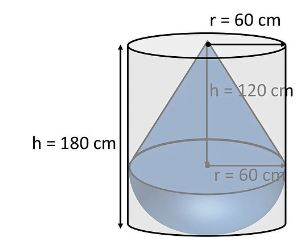
Volume of water left in cylinder \(=\) Volume of cylinder \(–\) Volume of solid
Volume of cylinder:
Radius \(=r=60 \mathrm{~cm}\)
Height \(=\mathrm{h}=180 \mathrm{~cm}\)
Volume of outer cylinder \(=\pi r^2 h=\frac{22}{7} \times(60)^2 \times 180=\frac{14256000}{7}\)
Volume of solid = Volume of cone + volume of hemisphere
Volume of cone:
Radius \(=r=60 \mathrm{~cm}\)
Height \(=\mathrm{h}=120 \mathrm{~cm}\)
Volume of cone \(=\frac{1}{3} \pi r^2 h=\frac{1}{3} \times \frac{22}{7} \times(60)^2 \times 120=\frac{3168000}{7} \mathrm{~cm}^3\)
Volume of hemisphere:
Radius \(=r=60 \mathrm{~cm}\)
Volume of hemisphere \(=\frac{2}{3} \pi r^3=\frac{2}{3} \times \frac{22}{7} \times 60^3=\frac{3168000}{7} \mathrm{~cm}^3\)
Hence, Volume of solid \(=\) Volume of cone \(+\) Volume of hemisphere
\(
\begin{aligned}
& =\frac{3168000}{7}+\frac{3168000}{7} \\
& =\frac{6336000}{7} \mathrm{~cm}^3
\end{aligned}
\)
Now, Volume of water left in cylinder
\(
\begin{aligned}
& =\text { Volume of cylinder }-\text { Volume of solid } \\
& =\frac{14256000}{7}-\frac{6336000}{7} \\
& =\frac{14256000-6336000}{7}==1.131 \mathrm{~m}^3 \text { (approximately) }
\end{aligned}
\) -
Question 29 of 57
29. Question
1 point(s)A spherical glass vessel has a cylindrical neck \(8 \mathrm{~cm}\) long, \(2 \mathrm{~cm}\) in diameter; the diameter of the spherical part is \(8.5 \mathrm{~cm}\). By measuring the amount of water it holds, a child finds its volume to be \(345 \mathrm{~cm}^3\). Check whether she is correct, taking the above as the inside measurements, and \(\pi=3.14\).
CorrectIncorrectHint
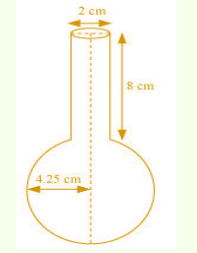
Radius of cylinder \(=1 \mathrm{~cm}\), height of cylinder \(=8 \mathrm{~cm}\), radius of sphere \(=8.5 \mathrm{~cm}\)
Volume of cylinder
\(
\begin{aligned}
& =\pi r^2 h \\
& =\pi \times 1^2 \times 8 \\
& =8 \pi \mathrm{cm}^3
\end{aligned}
\)
Volume of sphere
\(
\begin{aligned}
& =\frac{4}{3} \pi r^3 \\
& =\frac{4}{3} \pi \times\left(\frac{8.5}{2}\right)^3 \\
& =\frac{614125}{6000} \pi \mathrm{cm}^3
\end{aligned}
\)
Total volume \(=\) Volume of sphere \(+\) Volume of cylinder
\(
\begin{aligned}
& =\left(\frac{614125}{6000}+8\right) \pi \\
& =\left(\frac{614125+4809}{6000}\right) \pi \\
& =346.51 \mathrm{~cm}^3
\end{aligned}
\) -
Question 30 of 57
30. Question
1 point(s)A cone of height \(24 \mathrm{~cm}\) and radius of base \(6 \mathrm{~cm}\) is made up of modelling clay. A child reshapes it in the form of a sphere. Find the radius of the sphere.
CorrectIncorrectHint
Volume of cone \(=\frac{1}{3} \times \pi \times 6 \times 6 \times 24 \mathrm{~cm}^3\)
If \(r\) is the radius of the sphere, then its volume is \(\frac{4}{3} \pi r^3\).
Since, the volume of clay in the form of the cone and the sphere remains the same, we have
i.e.,
\(
\begin{aligned}
\frac{4}{3} \times \pi \times r^3 & =\frac{1}{3} \times \pi \times 6 \times 6 \times 24 \\
r^3 & =3 \times 3 \times 24=3^3 \times 2^3 \\
r & =3 \times 2=6
\end{aligned}
\)
So, \(\quad r=3 \times 2=6\)
Therefore, the radius of the sphere is \(6 \mathrm{~cm}\). -
Question 31 of 57
31. Question
1 point(s)ESelvi’s house has an overhead tank in the shape of a cylinder. This is filled by pumping water from a sump (an underground tank) which is in the shape of a cuboid. The sump has dimensions \(1.57 \mathrm{~m} \times 1.44 \mathrm{~m} \times 95 \mathrm{~cm}\). The overhead tank has its radius \(60 \mathrm{~cm}\) and height \(95 \mathrm{~cm}\). Find the height of the water left in the sump after the overhead tank has been completely filled with water from the sump which had been full. Compare the capacity of the tank with that of the sump. (Use \(\pi=3.14\) )
CorrectIncorrectHint
The volume of water in the overhead tank equals the volume of the water removed from the sump.
Now, the volume of water in the overhead tank (cylinder) \(=\pi r^2 h\)
\(
=3.14 \times 0.6 \times 0.6 \times 0.95 \mathrm{~m}^3
\)
The volume of water in the sump when full \(=l \times b \times h=1.57 \times 1.44 \times 0.95 \mathrm{~m}^3\)
The volume of water left in the sump after filling the tank
\(
=[(1.57 \times 1.44 \times 0.95)-(3.14 \times 0.6 \times 0.6 \times 0.95)] \mathrm{m}^3=(1.57 \times 0.6 \times 0.6 \times 0.95 \times 2) \mathrm{m}^3
\)
So, the height of the water left in the sump \(=\frac{\text { volume of water left in the sump }}{l \times b}\)
\(
\begin{aligned}
& =\frac{1.57 \times 0.6 \times 0.6 \times 0.95 \times 2}{1.57 \times 1.44} \mathrm{~m} \\
& =0.475 \mathrm{~m}=47.5 \mathrm{~cm}
\end{aligned}
\)
Also,
\(
\frac{\text { Capacity of tank }}{\text { Capacity of sump }}=\frac{3.14 \times 0.6 \times 0.6 \times 0.95}{1.57 \times 1.44 \times 0.95}=\frac{1}{2}
\)
Therefore, the capacity of the tank is half the capacity of the sump. -
Question 32 of 57
32. Question
1 point(s)A copper rod of diameter 1 cm and length 8 cm is drawn into a wire of length 18 m of uniform thickness. Find the thickness of the wire.
CorrectIncorrectHint
The volume of the rod \(=\pi \times\left(\frac{1}{2}\right)^2 \times 8 \mathrm{~cm}^3=2 \pi \mathrm{cm}^3\).
The length of the new wire of the same volume \(=18 \mathrm{~m}=1800 \mathrm{~cm}\)
If \(r\) is the radius (in cm) of the cross-section of the wire, its volume \(=\pi \times r^2 \times 1800 \mathrm{~cm}^3\)
Therefore,
i.e.,
\(
\begin{aligned}
\pi \times r^2 \times 1800 & =2 \pi \\
r^2 & =\frac{1}{900} \\
r & =\frac{1}{30}
\end{aligned}
\)
i.e.,
So, the diameter of the cross-section, i.e., the thickness of the wire is \(\frac{1}{15} \mathrm{~cm}\), i.e., \(0.67 \mathrm{~mm}\) (approx.). -
Question 33 of 57
33. Question
1 point(s)A hemispherical tank full of water is emptied by a pipe at the rate of \(3 \frac{4}{7}\) litres per second. How much time will it take to empty half the tank, if it is \(3 \mathrm{~m}\) in diameter? \(\left(\right.\) Take \(\pi=\frac{22}{7}\) )
CorrectIncorrectHint
Radius of the hemispherical tank \(=\frac{3}{2} \mathrm{~m}\)
\(
\text { Volume of the tank }=\frac{2}{3} \times \frac{22}{7} \times\left(\frac{3}{2}\right)^3 \mathrm{~m}^3=\frac{99}{14} \mathrm{~m}^3
\)
So, the volume of the water to be emptied \(=\frac{1}{2} \times \frac{99}{14} \mathrm{~m}^3=\frac{99}{28} \times 1000\) litres
\(
=\frac{99000}{28} \text { litres }
\)
Since, \(\frac{25}{7}\) litres of water is emptied in 1 second, \(\frac{99000}{28}\) litres of water will be emptied in \(\frac{99000}{28} \times \frac{7}{25}\) seconds, i.e., in \(16.5\) minutes. -
Question 34 of 57
34. Question
1 point(s)A metallic sphere of radius 4.2 cm is melted and recast into the shape of a cylinder of radius 6 cm. Find the height of the cylinder.
CorrectIncorrectHint
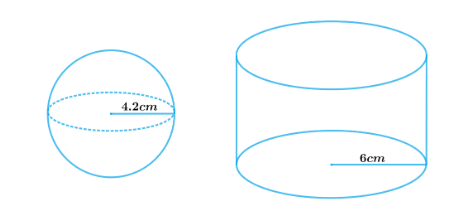
As a metallic sphere is melted and recast into the shape of a cylinder, their volume must be the same.
Volume of the sphere \(=\) Volume of the cylinder
Let us find the volume of the sphere and cylinder by using formulae;
Volume of the sphere \(=4 / 3 \pi r^3\) where \(r\) is the radius of the sphere
Volume of the cylinder \(=\pi r^2 h\) where \(r\) and \(h\) are radius and height of the cylinder respectively
Radius of the sphere, \(r_1=4.2 \mathrm{~cm}\)
Radius of the cylinder, \(r_2=6 \mathrm{~cm}\)
Let the height of the cylinder be \(h\).
Volume of sphere \(=\) Volume of cylinder
\(
\begin{aligned}
& 4 / 3 \pi r_1^3=\pi r_2^2 h \\
& (4 / 3) r_1^3=r_2^2 \mathrm{~h} \\
& \mathrm{~h}=4 r_1^3 / 3 r_2^2 \\
& =(4 \times 4.2 \mathrm{~cm} \times 4.2 \mathrm{~cm} \times 4.2 \mathrm{~cm}) /(3 \times 6 \mathrm{~cm} \times 6 \mathrm{~cm}) \\
& =2.744 \mathrm{~cm}
\end{aligned}
\)
Hence, the height of the cylinder so formed will be \(2.744 \mathrm{~cm}\). -
Question 35 of 57
35. Question
1 point(s)Metallic spheres of radii 6 cm, 8 cm, and 10 cm, respectively, are melted to form a single solid sphere. Find the radius of the resulting sphere.
CorrectIncorrectHint
Given:
Radius \(\left(\mathrm{r}_1\right)\) of first sphere \(=6 \mathrm{~cm}\)
Radius \(\left(\mathrm{r}_2\right)\) of second sphere \(=8 \mathrm{~cm}\)
Radius \(\left(\mathrm{r}_3\right)\) of third sphere \(=10 \mathrm{~cm}\)
Radius of the resulting sphere \(=r\)
The object formed by recasting these spheres will be same in volume as the sum of the voulmes of these spheres.
So, Volume of 3 spheres \(=\) Volume of resulting shape
\(
\frac{4}{3} \pi\left[r_1^3+r_2^3+r_3^3\right]=\frac{4}{3} \pi r^3
\)
\(
\Rightarrow \frac{4}{3} \pi\left[6^3+8^3+10^3\right]=\frac{4}{3} \pi r^3
\)
\(
\Rightarrow 216+512+1000=r^3
\)
\(
\Longrightarrow 1728=r^3
\)
\(
\mathrm{r}=12 \mathrm{~cm}
\)
Therefore, the radius of sphere so formed will be \(12 \mathrm{~cm}\). -
Question 36 of 57
36. Question
1 point(s)A 20 m deep well with a diameter of 7 m is dug and the earth from digging is evenly spread out to form a platform 22 m by 14 m. Find the height of the platform.
CorrectIncorrectHint
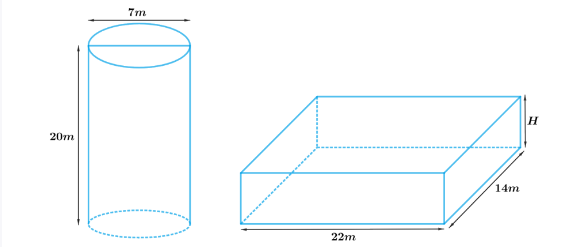
The shape of the well is considered to be cylindrical as shown in the figure.
Given:
Depth (h) of well \(=20 \mathrm{~m}\)
Radius (r) of circular end of well \(=\frac{7}{2} \mathrm{~m}\)
Area of platform = Length \(\times\) Breadth \(=22 \times 14 \mathrm{~m}^2\)
Assume height of the platform \(=\mathrm{H} \mathrm{m}\)
The volume of soil dug from the well will be equal to the volume of soil in platform.
Volume of soil from well = Volume of platform
\(\Rightarrow \pi r^2 \mathrm{~h}=\) Area of platform \(\times\) Height of platform
\(\pi \times\left(\frac{7}{2}\right)^2 \times 20=22 \times 14 \times \mathrm{H}\)
\(\mathrm{H}=\frac{22}{7} \times \frac{49}{4} \times \frac{20}{22 \times 14}\)
\(\mathrm{H}=\frac{5}{2}=2.5 \mathrm{~m}\)
Hence, the height of such a platform will be \(2.5 \mathrm{~m}\). -
Question 37 of 57
37. Question
1 point(s)A well of diameter 3 m is dug 14 m deep. The earth taken out of it has been spread evenly all around it in the shape of a circular ring of width 4 m to form an embankment. Find the height of the embankment.
CorrectIncorrectHint
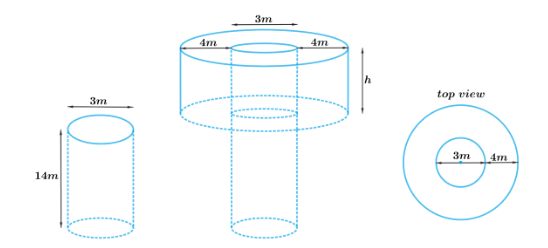
The volume of the earth taken out from well = Volume of the earth used to form the embankment
Hence, Volume of the cylindrical well = Volume of the hollow cylindrical embankment
Let us find the volume of the hollow cylindrical embankment by subtracting volume of inner cylinder from volume of the outer cylinder.
Volume of the cylinder \(=\pi r^2 \mathrm{~h}\) where \(r\) and \(\mathrm{h}\) are the radius and height of the cylinder respectively.
Depth of the cylindrical well, \(=h_1=14 \mathrm{~m}\)
Radius of the cylindrical well, \(=r=3 / 2 \mathrm{~m}=1.5 \mathrm{~m}\)
Width of embankment \(=4 \mathrm{~m}\)
Inner radius of the embankment, \(r=3 / 2 \mathrm{~m}=1.5 \mathrm{~m}\)
Outer radius of the embankment, \(\mathrm{R}=\) Inner radius + Width
\(
\begin{aligned}
& R=1.5 m+4 m =5.5 \mathrm{~m}
\end{aligned}
\)
Let the height of embankment be \(h\)
The volume of the cylindrical well = Volume of the hollow cylindrical embankment
\(
\begin{aligned}
& \pi r^2 h_1=\pi R^2 h-\pi r^2 h \\
& \pi r^2 h_1=\pi h\left(R^2-r^2\right) \\
& r^2 h_1=h(R-r)(R+r) \\
& h=\left[\left(r^2 h_1\right) /(R-r)(R+r)\right] \\
& h=\left[\left((1.5 \mathrm{~m})^2 \times 14 \mathrm{~m}\right) /(5.5 \mathrm{~m}-1.5 \mathrm{~m})(5.5 \mathrm{~m}+1.5 \mathrm{~m})\right] \\
& =\left(2.25 \mathrm{~m}^2 \times 14 \mathrm{~m}\right) /(4 \mathrm{~m} \times 7 \mathrm{~m}) \\
& =1.125 \mathrm{~m}
\end{aligned}
\)
Therefore, the height of the embankment will be \(1.125 \mathrm{~m}\). -
Question 38 of 57
38. Question
1 point(s)A container shaped like a right circular cylinder having diameter 12 cm and height 15 cm is full of ice cream. The ice cream is to be filled into cones of height 12 cm and diameter 6 cm, having a hemispherical shape on the top. Find the number of such cones which can be filled with ice cream.
CorrectIncorrectHint
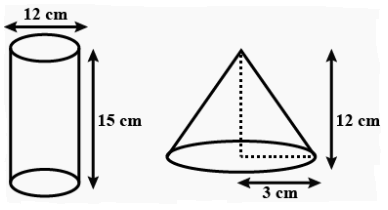
Height \(\left(\mathrm{h}_1\right)\) of cylindrical container \(=15 \mathrm{~cm}\)
\(
\text { Radius }=\frac{\text { Diameter }}{2}
\)
Radius \(\left(\mathrm{r}_1\right)\) of circular end of container \(=\frac{12}{2}=6 \mathrm{~cm}\)
Radius \(\left(\mathrm{r}_2\right)\) of circular end of ice-cream cone \(=\frac{6}{2}=3 \mathrm{~cm}\)
Height \(\left(\mathrm{h}_2\right)\) of conical part of ice-cream cone \(=12 \mathrm{~cm}\)
Let \(\mathrm{n}\) ice-cream cones be filled with ice-cream of the container.
Volume of ice-cream in cylinder \(=\mathrm{n}\) (Volume of 1 ice-cream cone \(+\) Volume of hemispherical shape on the top)
\(
\begin{aligned}
& \pi \mathrm{r}_1^2 \mathrm{~h}_1=\mathrm{n}\left(\frac{1}{3} \pi \mathrm{r}_2^2 \mathrm{~h}_2+\frac{2}{3} \pi \mathrm{r}_2^3\right) \\
& \Rightarrow \pi \times 6^2 \times 15=\mathrm{n}\left(\frac{1}{3} \pi 3^2 \times 12+\frac{2}{3} \pi 3^3\right) \\
& \Rightarrow \mathrm{n}=\frac{30 \times 15}{\frac{1}{3} \times 9 \times 12+\frac{2}{3} \times 27} \\
& \Rightarrow \mathrm{n}=\frac{36 \times 15 \times 3}{108+54} \\
& \mathrm{n}=10
\end{aligned}
\) -
Question 39 of 57
39. Question
1 point(s)How many silver coins, \(1.75 \mathrm{~cm}\) in diameter and of thickness \(2 \mathrm{~mm}\), must be melted to form a cuboid of dimensions \(5.5 \mathrm{~cm} \times 10 \mathrm{~cm} \times 3.5 \mathrm{~cm}\)?
CorrectIncorrectHint

From the figure, it can be seen that the shape of the silver coin is cylindrical. As we know that the silver coins are to be melted and recast into a single solid cuboid. Therefore the cuboid formed by recasting these coins will have the same volume equal to the sum of the volumes of these coins. Sum of the volumes of the silver coins \(=\) Volume of the cuboid.
Number of the coins \(\times\) volume of each coin \(=\) Volume of the cuboid
We will find the volume of the solids by using formulae;
Volume of the cuboid \(=\mathrm{lbh}\), where \(\mathrm{l}, \mathrm{b}\), and \(\mathrm{h}\) are the length, breadth, and height of the cuboid respectively, Volume of the cylinder \(=\pi r^2 h_1\), where \(r\) and \(h_1\) are the radius and height of the cylinder respectively
Dimensions of the cuboid, \(I \times b \times h=5.5 \mathrm{~cm} \times 10 \mathrm{~cm} \times 3.5 \mathrm{~cm}\)
Height of the cylindrical coin, \(h_1=2 \mathrm{~mm}=2 / 10 \mathrm{~cm}=0.2 \mathrm{~cm}\)
Radius of the cylindrical coin, \(r=1.75 / 2 \mathrm{~cm}=0.875 \mathrm{~cm}\)
Let \(n\) coins be melted to form the required cuboid.
Volume of \(n\) coins \(=\) Volume of cuboid
\(
\begin{aligned}
& n \times \pi r^2 h_1=1 \times b \times h \\
& n=(1 \times b \times h) / \pi r^2 h_1 \\
& =(5.5 \mathrm{~cm} \times 10 \mathrm{~cm} \times 3.5 \mathrm{~cm}) /\left[22 / 7 \times(0.875 \mathrm{~cm})^2 \times 0.2 \mathrm{~cm}\right] \\
& =(5.5 \mathrm{~cm} \times 10 \mathrm{~cm} \times 3.5 \mathrm{~cm} \times 7) /(22 \times 0.875 \mathrm{~cm} \times 0.875 \mathrm{~cm} \times 0.2 \mathrm{~cm}) \\
& =400
\end{aligned}
\)
Therefore, the number of coins melted to form such a cuboid is 400. -
Question 40 of 57
40. Question
1 point(s)A cylindrical bucket, 32 cm high and with radius of base 18 cm, is filled with sand. This bucket is emptied on the ground and a conical heap of sand is formed. If the height of the conical heap is 24 cm, find the radius and slant height of the heap.
CorrectIncorrectHint
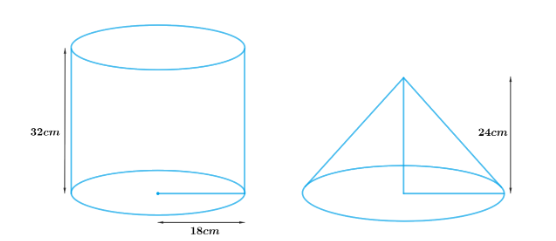
As it is given that a cylindrical bucket filled with sand is emptied on the ground and a conical heap of sand is formed, the volume of sand in the cylindrical bucket will be the same as the volume of the conical heap of sand. Therefore, volume of the conical heap of sand = volume of sand in the cylindrical bucket
Let us find the volume of the sand by using formulae;
Volume of the cylinder \(=\pi r^2 h\), where \(r\) and \(h\) are the radius and height of the cylinder respectively
Volume of the cone \(=1 / 3 \pi r^2 h\),
\(l=\sqrt{r^2}+h^2\)
where \(\mathrm{r}, \mathrm{h}\), and \(\mathrm{l}\) are radius, height, and slant height of the cone respectively.
Height of the cylindrical bucket, \(\mathrm{h}_1=32 \mathrm{~cm}\)
Radius of the cylindrical bucket, \(r_1=18 \mathrm{~cm}\), Height the of conical heap, \(h=24 \mathrm{~cm}\), Let the radius of the conical heap be \(r\) and slant height be \(l\).
volume of the conical heap of sand = volume of sand in the cylindrical bucket
\(
\begin{aligned}
& 1 / 3 \pi r^2 h=\pi r_1^2 h_1 \\
& r^2=3 r_1^2 h_1 / h \\
& r^2=\left[3 \times(18 \mathrm{~cm})^2 \times 32 \mathrm{~cm}\right] / 24 \mathrm{~cm} \\
& r^2=(18 \mathrm{~cm})^2 \times 4 \\
& r=18 \mathrm{~cm} \times 2=36 \mathrm{~cm}
\end{aligned}
\)
Slant height, \(l=\sqrt{r^2}+h^2\)
\(
\begin{aligned}
& =\sqrt{ }(36 \mathrm{~cm})^2+(24 \mathrm{~cm})^2=\sqrt{1296 \mathrm{~cm}^2+576 \mathrm{~cm}^2} \\
& =\sqrt{1872 \mathrm{~cm}^2}=12 \sqrt{13} \mathrm{~cm}
\end{aligned}
\)
Thus, the radius and slant height of the conical heap is \(36 \mathrm{~cm}\) and \(12 \sqrt{13}\) cm respectively. -
Question 41 of 57
41. Question
1 point(s)Water in a canal, \(6 \mathrm{~m}\) wide and \(1.5 \mathrm{~m}\) deep, is flowing with a speed of \(10 \mathrm{~km} / \mathrm{h}\). How much area will it irrigate in 30 minutes, if \(8 \mathrm{~cm}\) of standing water is needed?
CorrectIncorrectHint
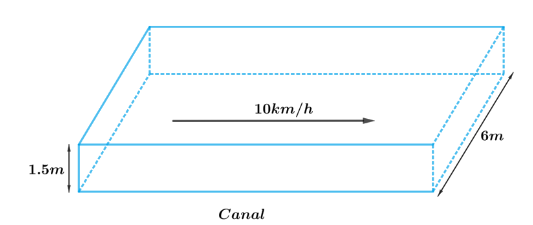
From the figure, it can be seen that the shape of the cross-section of the canal is cuboidal. So, the volume of the water, flowing at the speed of \(10 \mathrm{~km} / \mathrm{h}\) for 30 minutes will be the same as the volume of water needed to irrigate the area with \(8 \mathrm{~cm}\) of standing water. To find the volume of water we need to find the length of the water flowing through the canal in 30 minutes at the speed of \(10 \mathrm{~km} / \mathrm{h}\). Let us find the volume of the water by using the formula;
Volume of the cuboid \(=l \times b \times h\), where I, b, and \(h\) are the length, breadth, and height of the cuboid respectively.
Volume of the water to needed to irrigate the area \(=\) Area to be irrigated \(x\) height of the standing water
Volume of water flowing through the canal in 30 minutes \(=\) Area to be irrigated \(\times\) height of the standing water.
Width of the cuboidal canal, \(b=6 \mathrm{~m}\)
Depth of the cuboidal canal, \(h=1.5 \mathrm{~m}\)
The speed of water flowing through the canal is \(10 \mathrm{~km} / \mathrm{h}\)
Length of the water flowing through the canal in 1 hour ( 60 minutes) \(=10\) \(\mathrm{km}\)
Length of the water flowing through the canal in 30 minutes \(=10 \mathrm{~km} / 2=\) \(5 \mathrm{~km}\)
\(l=5 \times 1000 \mathrm{~m}=5000 \mathrm{~m}\)
Height of the standing water, \(h_1=8 \mathrm{~cm}=8 / 100 \mathrm{~m}=0.08 \mathrm{~m}\)
Volume of water flowing through the canal in 30 minutes \(=\) Area to be irrigated \(\times\) height of the standing water
\(\mathrm{l} \times \mathrm{b} \times \mathrm{h}=\) Area to be irrigated \(\times \mathrm{h}_1\)
Area to be irrigated \(=(1 \times b \times h) / h_1=(5000 \mathrm{~m} \times 6 \mathrm{~m} \times 1.5 \mathrm{~m}) / 0.08 \mathrm{~m}\)
\(=562500 \mathrm{~m}^2\)
Therefore, \(562500 \mathrm{~m}^2\) area will be irrigated in 30 minutes. -
Question 42 of 57
42. Question
1 point(s)A farmer connects a pipe of internal diameter \(20 \mathrm{~cm}\) from a canal into a cylindrical tank in her field, which is \(10 \mathrm{~m}\) in diameter and \(2 \mathrm{~m}\) deep. If water flows through the pipe at the rate of \(3 \mathrm{~km} / \mathrm{h}\), in how much time will the tank be filled?
CorrectIncorrectHint
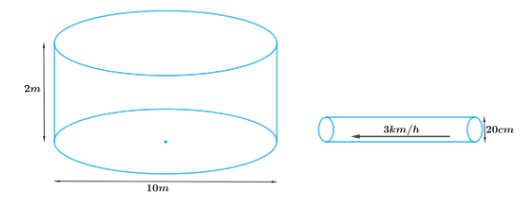
From the above figure, it can be seen that the shape of the cross-section of the pipe is cylindrical. So, the volume of the water, flowing at the speed of \(3 \mathrm{~km} / \mathrm{h}\) through the pipe to fill the tank will be the same as the volume of water in the cylindrical tank.
To find the volume of the water we need to find the length of the water flowing through the pipe at the speed of \(3 \mathrm{~km} / \mathrm{h}\).
Let us find the volume of the water by using the formula;
Volume of the cylinder \(=\pi r^2 \mathrm{~h}\), where \(r\) and \(\mathrm{h}\) are the radius and height of the cylinder respectively.
Therefore, the volume of water flowing through the pipe = volume of water in the cylindrical tank.
Radius of the cylindrical tank, \(R=10 / 2 \mathrm{~m}=5 \mathrm{~m}\)
Depth of the cylindrical tank, \(\mathrm{H}=2 \mathrm{~m}\)
Radius of the cylindrical pipe, \(r=20 / 2 \mathrm{~cm}=10 / 100 \mathrm{~m}=0.1 \mathrm{~m}\)
Length of the water flowing through the pipe in 1 hour ( 60 minutes) \(=3\) \(\mathrm{km}\)
Length of the water flowing through the pipe in 1 minute, \(\mathrm{h}=3 \mathrm{~km} / 60=\) \((3 \times 1000 \mathrm{~m}) / 60=50 \mathrm{~m}\)
Volume of water flowing through pipe in ‘ \(t\) ‘ minutes = volume of water in cylindrical tank
\(
\begin{aligned}
& t \times \pi r^2 h=\pi R^2 H \\
& t=R^2 H / r^2 h \\
& =(5 \mathrm{~m} \times 5 \mathrm{~m} \times 2 \mathrm{~m}) /(0.1 \mathrm{~m} \times 0.1 \mathrm{~m} \times 50 \mathrm{~m}) =100
\end{aligned}
\)
Therefore, the cylindrical tank will be filled in 100 minutes. -
Question 43 of 57
43. Question
1 point(s)The radii of the ends of a frustum of a cone \(45 \mathrm{~cm}\) high are \(28 \mathrm{~cm}\) and \(7 \mathrm{~cm}\) (see figure below). Find its volume\(\left(\right.\) Take \(\left.\pi=\frac{22}{7}\right)\).
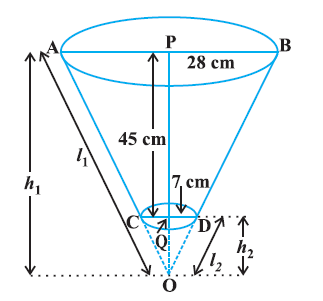 CorrectIncorrect
CorrectIncorrectHint
The frustum can be viewed as a difference of two right circular cones \(\mathrm{OAB}\) and OCD (see Figure). Let the height (in cm) of the cone \(\mathrm{OAB}\) be \(h_1\) and its slant height \(l_1\), i.e., \(\mathrm{OP}=h_1\) and \(\mathrm{OA}=\mathrm{OB}=l_1\). Let \(h_2\) be the height of cone \(\mathrm{OCD}\) and \(l_2\) its slant height.
We have \(: r_1=28 \mathrm{~cm}, r_2=7 \mathrm{~cm}\)
and the height of frustum \((h)=45 \mathrm{~cm}\). Also,
\(
h_1=45+h_2
\)
We first need to determine the respective heights \(h_1\) and \(h_2\) of the cone \(\mathrm{OAB}\) and \(\mathrm{OCD}\).
Since the triangles OPB and OQD are similar (Why?), we have
\(
\frac{h_1}{h_2}=\frac{28}{7}=\frac{4}{1}
\)
From (1) and (2), we get \(h_2=15\) and \(h_1=60\).
Now, the volume of the frustum \(=\) volume of the cone \(\mathrm{OAB}-\) volume of the cone \(\mathrm{OCD}\)
\(
=\left[\frac{1}{3} \cdot \frac{22}{7} \cdot(28)^2 \cdot(60)-\frac{1}{3} \cdot \frac{22}{7} \cdot(7)^2 \cdot(15)\right] \mathrm{cm}^3=48510 \mathrm{~cm}^3
\)Note:
\(
\text { Volume of the frustum of the cone }=\frac{1}{3} \pi h\left(r_1^2+r_2^2+r_1 r_2\right) \text {. }
\) -
Question 44 of 57
44. Question
1 point(s)The radii of the ends of a frustum of a cone \(45 \mathrm{~cm}\) high are \(28 \mathrm{~cm}\) and \(7 \mathrm{~cm}\) (see figure below). Find its curved surface area\(\left(\right.\) Take \(\left.\pi=\frac{22}{7}\right)\).
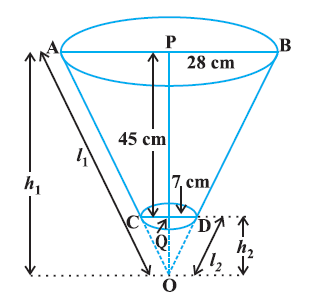 CorrectIncorrect
CorrectIncorrectHint
The frustum can be viewed as a difference of two right circular cones \(\mathrm{OAB}\) and OCD (see Figure). Let the height (in cm) of the cone \(\mathrm{OAB}\) be \(h_1\) and its slant height \(l_1\), i.e., \(\mathrm{OP}=h_1\) and \(\mathrm{OA}=\mathrm{OB}=l_1\). Let \(h_2\) be the height of cone \(\mathrm{OCD}\) and \(l_2\) its slant height.
We have \(: r_1=28 \mathrm{~cm}, r_2=7 \mathrm{~cm}\)
and the height of frustum \((h)=45 \mathrm{~cm}\). Also,
\(
h_1=45+h_2
\)
We first need to determine the respective heights \(h_1\) and \(h_2\) of the cone \(\mathrm{OAB}\) and \(\mathrm{OCD}\).
Since the triangles OPB and OQD are similar (Why?), we have
\(
\frac{h_1}{h_2}=\frac{28}{7}=\frac{4}{1}
\)
From (1) and (2), we get \(h_2=15\) and \(h_1=60\).
The respective slant height \(l_2\) and \(l_1\) of the cones \(\mathrm{OCD}\) and \(\mathrm{OAB}\) are given by
\(
\begin{aligned}
& l_2=\sqrt{(7)^2+(15)^2}=16.55 \mathrm{~cm} \text { (approx.) } \\
& l_1=\sqrt{(28)^2+(60)^2}=4 \sqrt{(7)^2+(15)^2}=4 \times 16.55=66.20 \mathrm{~cm}
\end{aligned}
\)
Thus, the curved surface area of the frustum \(=\pi r_1 l_1-\pi r_2 l_2\)
\(
=\frac{22}{7}(28)(66.20)-\frac{22}{7}(7)(16.55)=5461.5 \mathrm{~cm}^2
\)Note:
\(
\text { the curved surface area of the frustum of the cone }=\pi\left(r_1+r_2\right) l
\)\(
\text { where } l=\sqrt{h^2 \quad\left(\begin{array}{ll}
r_1 & r_2
\end{array}\right)^2} \text {. }
\) -
Question 45 of 57
45. Question
1 point(s)The radii of the ends of a frustum of a cone \(45 \mathrm{~cm}\) high are \(28 \mathrm{~cm}\) and \(7 \mathrm{~cm}\) (see figure below). Find its total surface area\(\left(\right.\) Take \(\left.\pi=\frac{22}{7}\right)\).
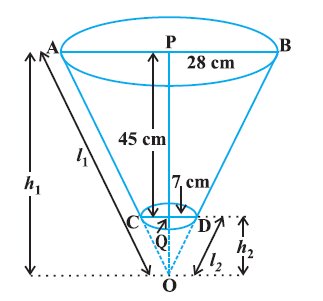 CorrectIncorrect
CorrectIncorrectHint
The frustum can be viewed as a difference of two right circular cones \(\mathrm{OAB}\) and OCD (see Figure). Let the height (in cm) of the cone \(\mathrm{OAB}\) be \(h_1\) and its slant height \(l_1\), i.e., \(\mathrm{OP}=h_1\) and \(\mathrm{OA}=\mathrm{OB}=l_1\). Let \(h_2\) be the height of cone \(\mathrm{OCD}\) and \(l_2\) its slant height.
We have \(: r_1=28 \mathrm{~cm}, r_2=7 \mathrm{~cm}\)
and the height of frustum \((h)=45 \mathrm{~cm}\). Also,
\(
h_1=45+h_2
\)
We first need to determine the respective heights \(h_1\) and \(h_2\) of the cone \(\mathrm{OAB}\) and \(\mathrm{OCD}\).
Since the triangles OPB and OQD are similar (Why?), we have
\(
\frac{h_1}{h_2}=\frac{28}{7}=\frac{4}{1}
\)
From (1) and (2), we get \(h_2=15\) and \(h_1=60\).
The respective slant height \(l_2\) and \(l_1\) of the cones \(\mathrm{OCD}\) and \(\mathrm{OAB}\) are given by
\(
\begin{aligned}
& l_2=\sqrt{(7)^2+(15)^2}=16.55 \mathrm{~cm} \text { (approx.) } \\
& l_1=\sqrt{(28)^2+(60)^2}=4 \sqrt{(7)^2+(15)^2}=4 \times 16.55=66.20 \mathrm{~cm}
\end{aligned}
\)
Thus, the curved surface area of the frustum \(=\pi r_1 l_1-\pi r_2 l_2\)
\(
=\frac{22}{7}(28)(66.20)-\frac{22}{7}(7)(16.55)=5461.5 \mathrm{~cm}^2
\)Now, the total surface area of the frustum
\(
\begin{aligned}
& =\text { the curved surface area }+\pi r_1^2+\pi r_2^2 \\
& =5461.5 \mathrm{~cm}^2+\frac{22}{7}(28)^2 \mathrm{~cm}^2+\frac{22}{7}(7)^2 \mathrm{~cm}^2 \\
& =5461.5 \mathrm{~cm}^2+2464 \mathrm{~cm}^2+154 \mathrm{~cm}^2=8079.5 \mathrm{~cm}^2 .
\end{aligned}
\)Note:
\(
\text { Total surface area of the frustum of the cone }=\pi l\left(r_1+r_2\right)+\pi r_1^2+\pi r_2^2 \text {, }
\)\(
\text { where } l=\sqrt{h^2 \quad\left(\begin{array}{ll}
r_1 & r_2
\end{array}\right)^2} \text {. }
\) -
Question 46 of 57
46. Question
1 point(s)Hanumappa and his wife Gangamma are busy making jaggery out of sugarcane juice. They have processed the sugarcane juice to make the molasses, which is poured into moulds in the shape of a frustum of a cone having the diameters of its two circular faces as \(30 \mathrm{~cm}\) and \(35 \mathrm{~cm}\) and the vertical height of the mould is \(14 \mathrm{~cm}\) (see figure below). If each \(\mathrm{cm}^3\) of molasses has mass about \(1.2 \mathrm{~g}\), find the mass of the molasses that can be poured into each mould. \(\left(\right.\) Take \(\left.\pi=\frac{22}{7}\right)\)
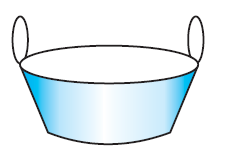 CorrectIncorrect
CorrectIncorrectHint
Since the mould is in the shape of a frustum of a cone, the quantity (volume) of molasses that can be poured into it \(=\frac{\pi}{3} h\left(r_1^2+r_2^2+r_1 r_2\right)\),
where \(r_1\) is the radius of the larger base and \(r_2\) is the radius of the smaller base.
\(
=\frac{1}{3} \times \frac{22}{7} \times 14\left[\left(\frac{35}{2}\right)^2+\left(\frac{30}{2}\right)^2+\left(\frac{35}{2} \times \frac{30}{2}\right)\right] \mathrm{cm}^3=11641.7 \mathrm{~cm}^3 .
\)
It is given that \(1 \mathrm{~cm}^3\) of molasses has mass \(1.2 \mathrm{~g}\). So, the mass of the molasses that can be poured into each mould \(=(11641.7 \times 1.2) \mathrm{g}\)
\(
=13970.04 \mathrm{~g}=13.97 \mathrm{~kg}=14 \mathrm{~kg} \text { (approx.) }
\) -
Question 47 of 57
47. Question
1 point(s)An open metal bucket is in the shape of a frustum of a cone, mounted on a hollow cylindrical base made of the same metallic sheet (see figure below). The diameters of the two circular ends of the bucket are \(45 \mathrm{~cm}\) and \(25 \mathrm{~cm}\), the total vertical height of the bucket is \(40 \mathrm{~cm}\) and that of the cylindrical base is \(6 \mathrm{~cm}\). Find the area of the metallic sheet used to make the bucket, where we do not take into account the handle of the bucket. Also, find the volume of water the bucket can hold.
Take \(\pi=\frac{22}{7}\).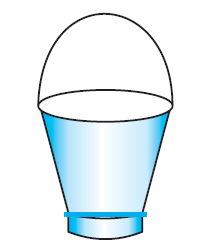 CorrectIncorrect
CorrectIncorrectHint
The total height of the bucket \(=40 \mathrm{~cm}\), which includes the height of the base. So, the height of the frustum of the cone \(=(40-6) \mathrm{cm}=34 \mathrm{~cm}\).
where \(r_1=22.5 \mathrm{~cm}, r_2=12.5 \mathrm{~cm}\) and \(h=34 \mathrm{~cm}\).
So,
\(
\begin{aligned}
l & =\sqrt{34^2+(22.5-12.5)^2} \mathrm{~cm} \\
& =\sqrt{34^2+10^2}=35.44 \mathrm{~cm}
\end{aligned}
\)
The area of metallic sheet used \(=\) curved surface area of frustum of cone
\(+\) area of circular base
\(+\) curved surface area of cylinder
\(=\left[\pi \times 35.44(22.5+12.5)+\pi \times(12.5)^2\right.\)
\(+2 \pi \times 12.5 \times 6] \mathrm{cm}^2\)
\(=\frac{22}{7}(1240.4+156.25+150) \mathrm{cm}^2\)
\(=4860.9 \mathrm{~cm}^2\)
Now, the volume of water that the bucket can hold (also, known as the capacity of the bucket)
\(
\begin{aligned}
& =\frac{\pi \times h}{3} \times\left(r_1^2+r_2^2+r_1 r_2\right) \\
& =\frac{22}{7} \times \frac{34}{3} \times\left[(22.5)^2+(12.5)^2+22.5 \times 12.5\right] \mathrm{cm}^3 \\
& =\frac{22}{7} \times \frac{34}{3} \times 943.75=33615.48 \mathrm{~cm}^3 \\
& =33.62 \text { litres (approx.) }
\end{aligned}
\) -
Question 48 of 57
48. Question
1 point(s)A drinking glass is in the shape of a frustum of a cone of height \(14 \mathrm{~cm}\). The diameters of its two circular ends are \(4 \mathrm{~cm}\) and \(2 \mathrm{~cm}\). Find the capacity of the glass.
CorrectIncorrectHint

As mentioned that the glass is in the shape of a frustum of a cone
Therefore, the capacity of the glass = Volume of the frustum of the cone.
Let us find the capacity of the glass by using formulae
Volume of a frustum of a cone \(=1 / 3 \pi h\left(r_1^2+r_2^2+r_1 r_2\right)\), where \(r_1, r_2\), and \(h\) are the radii and height of the frustum of the cone respectively.
Height of glass, \(h=14 \mathrm{~m}\)
Radius of the larger base, \(r_1=4 \mathrm{~cm} / 2=2 \mathrm{~cm}\)
Radius of the smaller base, \(r_2=2 \mathrm{~cm} / 2=1 \mathrm{~cm}\)
The capacity of the glass \(=\) Volume of frustum of a cone \(=1 / 3 \pi h\left(r_1{ }^2+r_2{ }^2\right.\) \(\left.+r_1 r_2\right)\)
\(
=1 / 3 \times 22 / 7 \times 14 \mathrm{~cm} \times(2 \mathrm{~cm})^2+(1 \mathrm{~cm})^2+2 \mathrm{~cm} \times 1 \mathrm{~cm}
\)
\(
\begin{aligned}
& =44 / 3 \mathrm{~cm} \times\left(4 \mathrm{~cm}^2+1 \mathrm{~cm}^2+2 \mathrm{~cm}^2\right) \\
& =44 / 3 \mathrm{~cm} \times 7 \mathrm{~cm}^2 \\
& =308 / 3 \mathrm{~cm}^2 \\
& =102 2 / 3 \mathrm{~cm}^2
\end{aligned}
\)
Therefore, the capacity of the glass is \(102 2 / 3 \mathrm{~cm}^3\). -
Question 49 of 57
49. Question
1 point(s)The slant height of a frustum of a cone is \(4 \mathrm{~cm}\) and the perimeters (circumference) of its circular ends are \(18 \mathrm{~cm}\) and \(6 \mathrm{~cm}\). Find the curved surface area of the frustum.
CorrectIncorrectHint
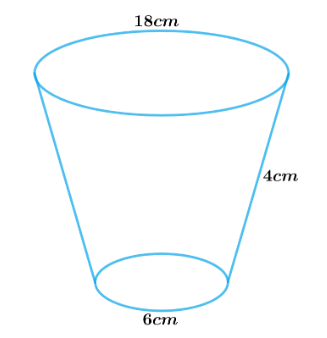
Circumference of the circle \(=2 \pi r\), where \(r\) is the radius of the circle
Let us find the CSA of the frustum by using the formula;
CSA of a frustum of a cone \(=\pi\left(r_1+r_2\right) l\), where \(r_1, r_2\), and \(l\) are the radii and slant height of the frustum of the cone respectively.
Slant height of frustum of a cone, \(l=4 \mathrm{~cm}\)
Circumference of the larger circular end, \(\mathrm{C}_1=18 \mathrm{~cm}\)
Radius of the larger circular end, \(r=C_1 / 2 \pi=18 \mathrm{~cm} / / 2 \pi=9 / \pi \mathrm{cm}\)
Circumference of the smaller circular end, \(\mathrm{C}_2=6 \mathrm{~cm}\)
Radius of the smaller circular end, \(\mathrm{r}_2=\mathrm{C}_2 / 2 \pi=6 \mathrm{~cm} / 2 \pi=3 / \pi \mathrm{cm}\)
CSA of frustum of a cone \(=\pi\left(r_1+r_2\right)l\)
\(=\pi(9 / \pi \mathrm{cm}+3 / \pi \mathrm{cm}) \times 4 \mathrm{~cm}\)
\(=48 \mathrm{~cm}^2\)
The curved surface area of the frustum is \(48 \mathrm{~cm}^2\). -
Question 50 of 57
50. Question
1 point(s)A \(f e z\), the cap used by the Turks, is shaped like the frustum of a cone (see figure below). If its radius on the open side is \(10 \mathrm{~cm}\), radius at the upper base is \(4 \mathrm{~cm}\) and its slant height is \(15 \mathrm{~cm}\), find the area of material used for making it.
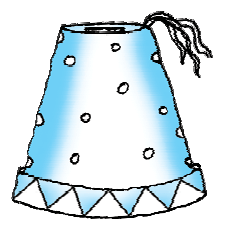 CorrectIncorrect
CorrectIncorrectHint
Since the fez is in the shape of the frustum of a cone and is open at the bottom.
Therefore,
Area of material used for making \(f e z=\) Curved Surface Area of the frustum + Area of the upper circular end
Let us find the area of material by using formulae;
CSA of frustum of a cone \(=\pi\left(r_1+r_2\right) \mid\)
where \(r_1, r_2\) and I are the radii and slant height of the frustum of the cone respectively.
Area of the circle \(=\pi r^2\)
where \(r\) is the radius of the circle
Slant height, \(l=15 \mathrm{~cm}\)
Radius of open side, \(r_1=10 \mathrm{~cm}\)
Radius of upper base, \(r_2=4 \mathrm{~cm}\)
Area of material used for making \(\mathrm{fez}=\) Curved Surface area of the frustum
\(+\) area of the upper circular end
\(=\pi\left(r_1+r_2\right) \mid+\pi r_2^2\)
\(=\pi\left[\left(r_1+r_2\right) \mid+r_2{ }^2\right]\)
\(=22 / 7\left[(10 \mathrm{~cm}+4 \mathrm{~cm}) 15 \mathrm{~cm}+(4 \mathrm{~cm})^2\right]\)
\(
=710.29 \mathrm{~cm}^2
\)
\(710.29 \mathrm{~cm}^2\) of the material used for making Fez. -
Question 51 of 57
51. Question
1 point(s)A container opened from the top and made up of a metal sheet, is in the form of a frustum of a cone of height \(16 \mathrm{~cm}\) with radii of its lower and upper ends as \(8 \mathrm{~cm}\) and 20 \(\mathrm{cm}\), respectively. Find the cost of the milk which can completely fill the container, at the rate of c 20 per litre. Also, find the cost of the metal sheet used to make the container, if it costs c 8 per \(100 \mathrm{~cm}^2 .(\) Take \(\pi=3.14)\)
CorrectIncorrectHint
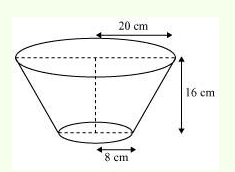
Radius \(\left(r_1\right)\) of upper end of container \(=20 \mathrm{~cm}\)
Radius \(\left(r_2\right)\) of lower end of container \(=8 \mathrm{~cm}\)
Height \((h)\) of container \(=16 \mathrm{~cm}\)
Slant height ( 1 of frustum \(=\sqrt{\left(r_1-r_2\right)^2+h^2}\)
\(
\begin{aligned}
& =\sqrt{(20-8)^2+(16)^2} \\
& =\sqrt{(12)^2+(16)^2}=\sqrt{144+256}=20 \mathrm{~cm}
\end{aligned}
\)
Capacity of container \(=\) Volume of frustum
\(
\begin{aligned}
& =\frac{1}{3} \pi h\left(r_1^2+r_2^2+r_1 r_2\right) \\
& =\frac{1}{3} \times 3.14 \times 16 \times\left[(20)^2+(8)^2+(20)(8)\right] \\
& =\frac{1}{3} \times 3.14 \times 16(400+64+160) \\
& =\frac{1}{3} \times 3.14 \times 16 \times 624 \\
& =10449.92 \mathrm{~cm}^3=10.45 \text { litres. } \\
& \text { Cost of } 1 \text { litre milk }=\text { Rs } 20 \\
& \text { Cost of } 10.45 \text { litre milk }=10.45 \times 20 =\text { Rs } 209
\end{aligned}
\)
Area of metal sheet used to make the container
\(
\begin{aligned}
& =\pi\left(r_1+r_2\right) l+\pi r_2^2 \\
& =\pi(20+8) 20+\pi(8)^2 \\
& =560 \pi+64 \pi=624 \pi \mathrm{cm}^2
\end{aligned}
\)
Cost of \(100 \mathrm{~cm}^2\) metal sheet \(=\) Rs 8
Cost of \(624 \mathrm{~cm}^2\) metal sheet \(=\frac{624 \times 3.14 \times 8}{100}\)
\(=156.75\)
Therefore, the cost of the milk which can completely fill the container is Rs 209 and the cost of metal sheet used to make the container is Rs \(156.75\). -
Question 52 of 57
52. Question
1 point(s)A metallic right circular cone \(20 \mathrm{~cm}\) high and whose vertical angle is \(60^{\circ}\) is cut into two parts at the middle of its height by a plane parallel to its base. If the frustum so obtained be drawn into a wire of diameter \(\frac{1}{16} \mathrm{~cm}\), find the length of the wire.
CorrectIncorrectHint
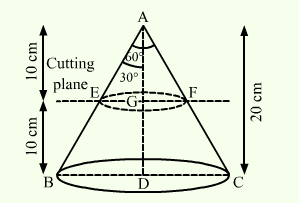
We have, Height of the solid metallic cone, \(H=20 \mathrm{~cm}\),
Height of the frustum, \(h=\frac{20}{2}=10 \mathrm{~cm}\) and
Radius of the wire \(=\frac{1}{24} \mathrm{~cm}\)
Let the length of the wire be \(l, \mathrm{EG}=r\) and \(\mathrm{BD}=R\).
In \(\triangle \mathrm{AEG}\)
\(
\begin{aligned}
& \tan 30^{\circ}=\frac{\mathrm{EG}}{\mathrm{AG}} \\
& \Rightarrow \frac{1}{\sqrt{3}}=\frac{r}{H-h} \\
& \Rightarrow \frac{1}{\sqrt{3}}=\frac{r}{20-10} \\
& \Rightarrow r=\frac{10}{\sqrt{3}} \mathrm{~cm}
\end{aligned}
\)
Also, in \(\triangle \mathrm{ABD}\),
\(
\begin{aligned}
& \tan 30^{\circ}=\frac{\mathrm{BD}}{\mathrm{AD}} = \frac{1}{\sqrt{3}}=\frac{R}{H} \\
& \Rightarrow \frac{1}{\sqrt{3}}=\frac{R}{20} \\
& \Rightarrow R=\frac{20}{\sqrt{3}} \mathrm{~cm}
\end{aligned}
\)
Now, Volume of the wire \(=\) Volume of the frustum
\(
\begin{aligned}
& \Rightarrow \pi\left(\frac{1}{24}\right)^2 l=\frac{1}{3} \pi h\left(R^2+r^2+R r\right) \\
& \Rightarrow \frac{l}{576}=\frac{1}{3} \times 10 \times\left[\left(\frac{20}{\sqrt{3}}\right)^2+\left(\frac{10}{\sqrt{3}}\right)^2+\left(\frac{20}{\sqrt{3}}\right)\left(\frac{10}{\sqrt{3}}\right)\right] \\
& \Rightarrow l=\frac{576}{3} \times 10 \times\left[\frac{400}{3}+\frac{100}{3}+\frac{200}{3}\right] \\
& \Rightarrow l=\frac{576}{3} \times 10 \times \frac{700}{3} =4480 \mathrm{~m}
\end{aligned}
\) -
Question 53 of 57
53. Question
1 point(s)A copper wire, \(3 \mathrm{~mm}\) in diameter, is wound about a cylinder whose length is \(12 \mathrm{~cm}\), and diameter \(10 \mathrm{~cm}\), so as to cover the curved surface of the cylinder. Find the length and mass of the wire, assuming the density of copper to be \(8.88 \mathrm{~g}\) per \(\mathrm{cm}^3\).
CorrectIncorrectHint
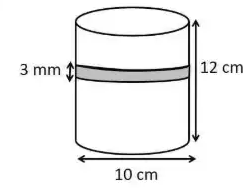
From the figure, we can observe that 1 round of wire will cover \(3 \mathrm{~mm}\) height of the cylinder.
\(
\begin{aligned}
& \text { Number of rounds }=\frac{\text { Height of cylinder }}{\text { Diameter of wire }} \\
& =\frac{12}{0.3}=40 \text { rounds. }
\end{aligned}
\)
Length of wire required in 1 round = Circumference of base of cylinder
\(
=2 \pi \mathrm{r}=2 \pi 5=10 \pi
\)
Length of wire in 40 rounds \(=40 \times 10 \pi\)
\(
\begin{aligned}
& =\frac{400 \times 22}{7}=\frac{8800}{7}=1257.14 \mathrm{~cm}=12.57 \mathrm{~m}
\end{aligned}
\)
\(
\text { Radius of wire }=\frac{0.3}{2}=0.15 \mathrm{~cm} .
\)
Volume of wire \(=\) Area of cross-section of wire \(x\) Length of wire
\(
\begin{aligned}
& =\pi(0.15)^2 \times 1257.14=88.898 \mathrm{~cm}^3
\end{aligned}
\)
\(
\begin{aligned}
& \text { Mass }=\text { Volume } \times \text { Density } \\
& =88.898 \times 8.88=789.41 \mathrm{gm}
\end{aligned}
\) -
Question 54 of 57
54. Question
1 point(s)A right triangle, whose sides are \(3 \mathrm{~cm}\) and \(4 \mathrm{~cm}\) (other than hypotenuse) is made to revolve about its hypotenuse. Find the volume and surface area of the double cone so formed. (Choose value of \(\pi\) as found appropriate.)
CorrectIncorrectHint
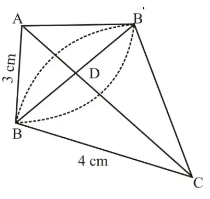
The double cone so formed by revolving this right-angled triangle \(\mathrm{ABC}\) about its hypotenuse is shown in the figure.
Hypotenuse, \(\mathrm{AC}=\sqrt{3^2+4^2}\)
\(
=\sqrt{9+16}=\sqrt{25}=5 \mathrm{~cm}
\)
Area of \(\triangle \mathrm{ABC}=\frac{1}{2} \times \mathrm{AB} \times \mathrm{AC}\)
\(
\Rightarrow \frac{1}{2} \times \mathrm{AC} \times \mathrm{DB}=\frac{1}{2} \times 4 \times 3
\)
\(
\Rightarrow \frac{1}{2} \times 5 \times \mathrm{DB}=6
\)
So, \(\mathrm{DB}=\frac{12}{5}=2.4 \mathrm{~cm}\)
The volume of double cone \(=\) Volume of cone \(1+\) Volume of cone 2
\(
=\frac{1}{3} \pi \mathrm{r}^2 \mathrm{~h}_1+\frac{1}{3} \pi \mathrm{r}^2 \mathrm{~h}_2
\)
\(
=\frac{1}{3} \pi r^2\left[\mathrm{~h}_1+\mathrm{h}_2\right]=\frac{1}{3} \pi \mathrm{r}^2[\mathrm{DA}+\mathrm{DC}]
\)
\(
\begin{aligned}
& =\frac{1}{3} \times 3.14 \times 2.4^2 \times 5 =30.14 \mathrm{~cm}^3
\end{aligned}
\)
The surface area of double cone \(=\) Surface area of cone \(1+\) Surface area of cone 2
\(
\begin{aligned}
& =\pi \mathrm{rl}_1+\pi \mathrm{rl}_2 =\pi r[4+3]=3.14 \times 2.4 \times 7 =52.75 \mathrm{~cm}^2
\end{aligned}
\) -
Question 55 of 57
55. Question
1 point(s)A cistern, internally measuring \(150 \mathrm{~cm} \times 120 \mathrm{~cm} \times 110 \mathrm{~cm}\), has \(129600 \mathrm{~cm}^3\) of water in it. Porous bricks are placed in the water until the cistern is full to the brim. Each brick absorbs one-seventeenth of its own volume of water. How many bricks can be put in without overflowing the water, each brick being \(22.5 \mathrm{~cm} \times 7.5 \mathrm{~cm} \times 6.5 \mathrm{~cm}\)?
CorrectIncorrectHint
Volume of cistern \(=150 \times 120 \times 110\)
\(=1980000 \mathrm{~cm}^3\)
Volume to be filled in cistern \(=1980000-129600\)
\(=1850400 \mathrm{~cm}^3\)
Let \(n\) numbers of porous bricks were placed in the cistern.
Volume of \(n\) bricks \(=n \times 22.5 \times 7.5 \times 6.5\)
\(
=1096.875 n
\)
As each brick absorbs one-seventeenth of its volume, therefore, volume absorbed by these bricks
\(
\begin{aligned}
& =\mathrm{n} / 17(1096.875) \\
& 1850400+\frac{n}{17}(1096.875)=(1096.875) n \\
& 1850400=\frac{16 n}{17}(1096.875) \\
& n=1792.41
\end{aligned}
\)
Therefore, 1792 bricks were placed in the cistern. -
Question 56 of 57
56. Question
1 point(s)In one fortnight of a given month, there was a rainfall of \(10 \mathrm{~cm}\) in a river valley. If the area of the valley is \(7280 \mathrm{~km}^2\), show that the total rainfall was approximately equivalent to the addition to the normal water of three rivers each \(1072 \mathrm{~km}\) long, \(75 \mathrm{~m}\) wide and \(3 \mathrm{~m}\) deep.
CorrectIncorrectHint
Area of the valley \(=7280 \mathrm{~km}^2\)
If there was a rainfall of \(10 \mathrm{~cm}\) in the valley then amount of rainfall in the valley \(=\) Area of the valley \(\times 10 \mathrm{~cm}\)
Amount of rainfall in the valley \(=7280 \mathrm{~km}^2 \times 10 \mathrm{~cm}\)
\(
\begin{aligned}
& =7280 \times(1000 \mathrm{~m})^2 \times \frac{10}{100} \mathrm{~m} \\
& =7280 \times 10^5 \mathrm{~m}^3 \\
& =7.28 \times 10^8 \mathrm{~m}^3
\end{aligned}
\)
Length of each river, \(l=1072 \mathrm{~km}=1072 \times 1000 \mathrm{~m}=1072000 \mathrm{~m}\)
Breadth of each river, \(b=75 \mathrm{~m}\)
Depth of each river, \(h=3 \mathrm{~m}\)
Volume of each river \(=l \times b \times h\)
\(=1072000 \times 75 \times 3 \mathrm{~m}^3\)
\(=2.412 \times 10^8 \mathrm{~m}^3\)
Volume of three such rivers \(=3 \times\) Volume of each river
\(
=3 \times 2.412 \times 10^8 \mathrm{~m}^3
\)
\(
=7.236 \times 10^8 \mathrm{~m}^3
\)
Thus, the total rainfall is approximately same as the volume of the three river -
Question 57 of 57
57. Question
1 point(s)An oil funnel made of tin sheet consists of a \(10 \mathrm{~cm}\) long cylindrical portion attached to a frustum of a cone. If the total height is \(22 \mathrm{~cm}\), diameter of the cylindrical portion is \(8 \mathrm{~cm}\) and the diameter of the top of the funnel is \(18 \mathrm{~cm}\), find the area of the tin sheet required to make the funnel (see figure below).
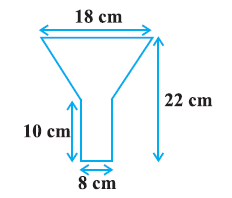 CorrectIncorrect
CorrectIncorrectHint
Radius \(\left(r_1\right)\) of upper circular end of frustum part \(=18 / 2=9 \mathrm{~cm}\)
Radius \(\left(r_2\right)\) of lower circular end of frustum part \(=\) Radius of circular end of cylindrical par \(=8 / 2=4 \mathrm{~cm}\)
Height \(\left(h_1\right)\) of frustum part \(=22-10=12 \mathrm{~cm}\)
Height \(\left(h_2\right)\) of cylindrical part \(=10 \mathrm{~cm}\)
Slant height \((l)\) of frustum part \(=\)
\(
\sqrt{r_1-r_2^2+h_2}=\sqrt{(9-4)^2+(12)^2}=13 \mathrm{~cm}
\)
Area of tin sheet required \(=\) CSA of frustum part \(+\) CSA of cylindrical part
\(
\begin{aligned}
& =\pi\left(r_1+r_2\right) l+2 \pi r_2 h_2 \\
& =\frac{22}{7} \times(9+4) \times 13+\frac{22}{7} \times 4 \times 10 \\
& =\frac{22}{7}[169+80]=\frac{22 \times 249}{7} \\
& =782 \frac{4}{7} \mathrm{~cm}^2
\end{aligned}
\)